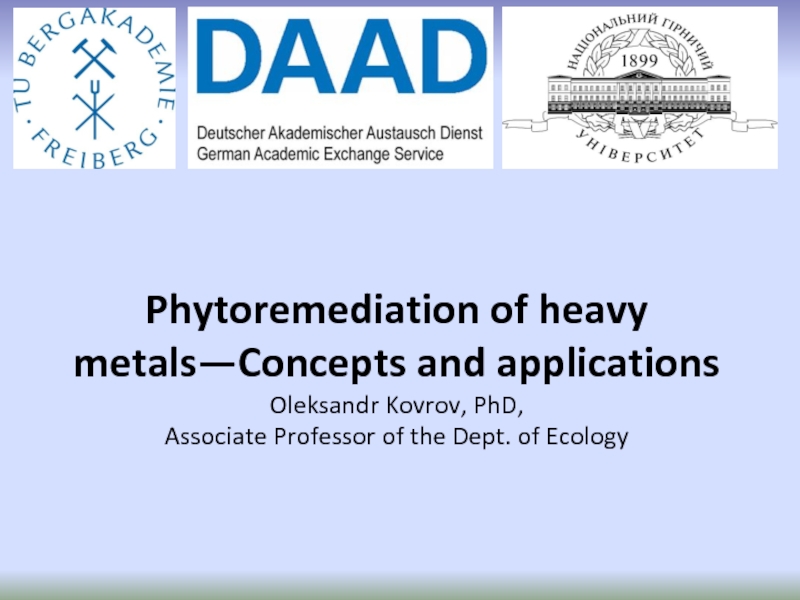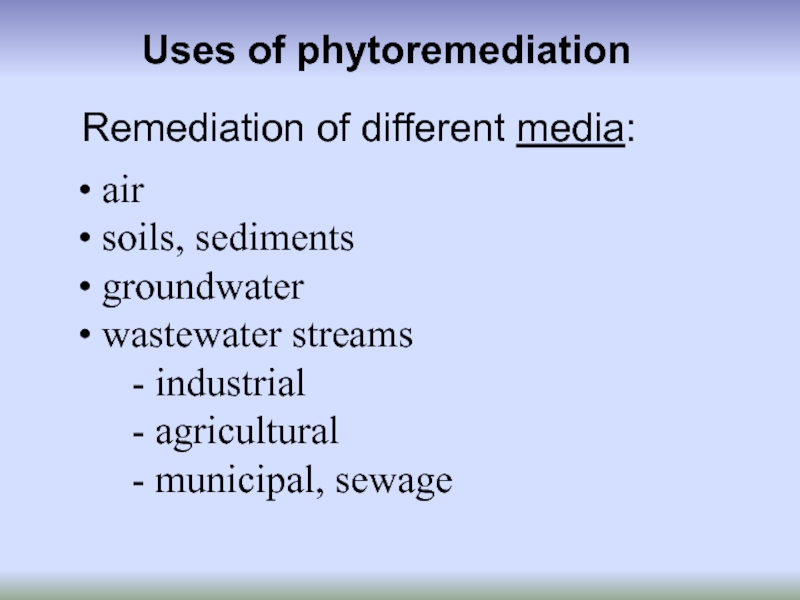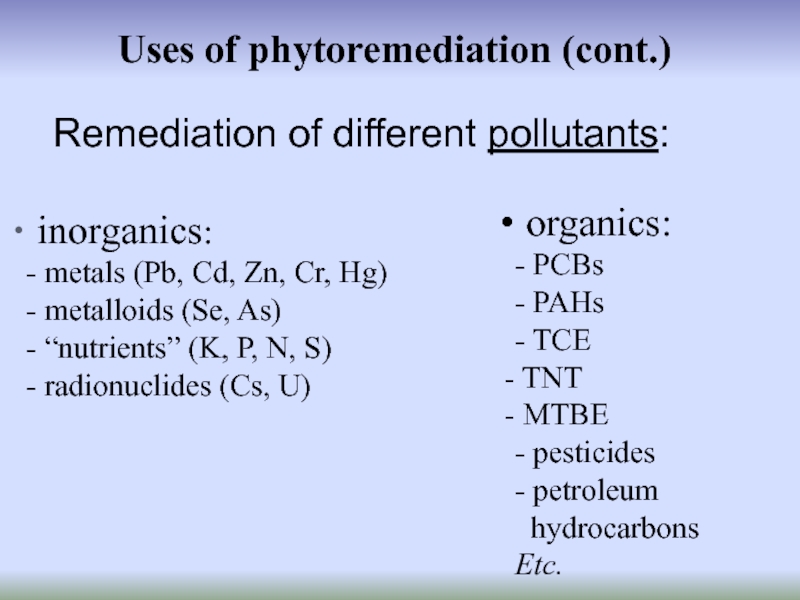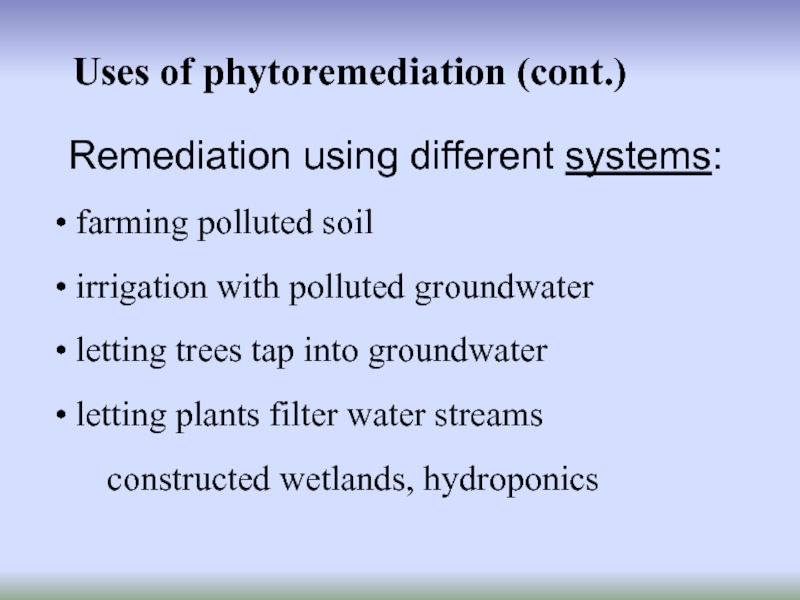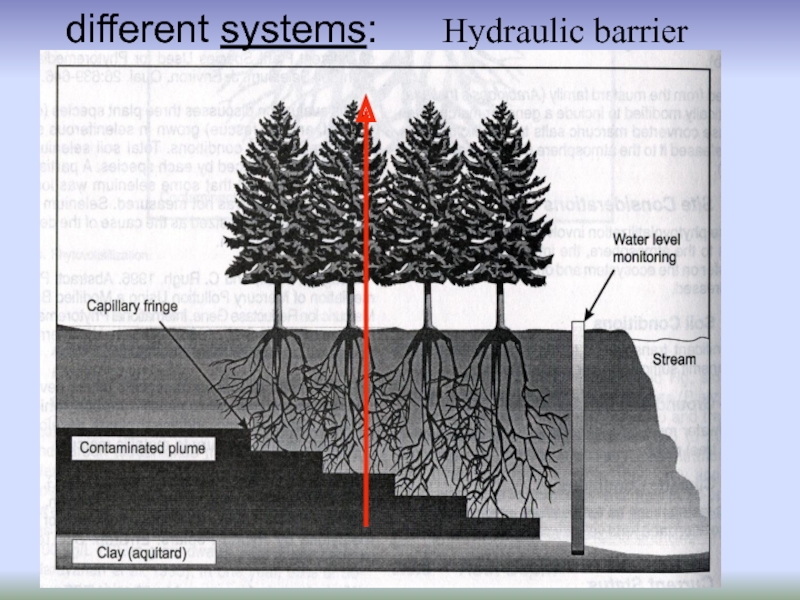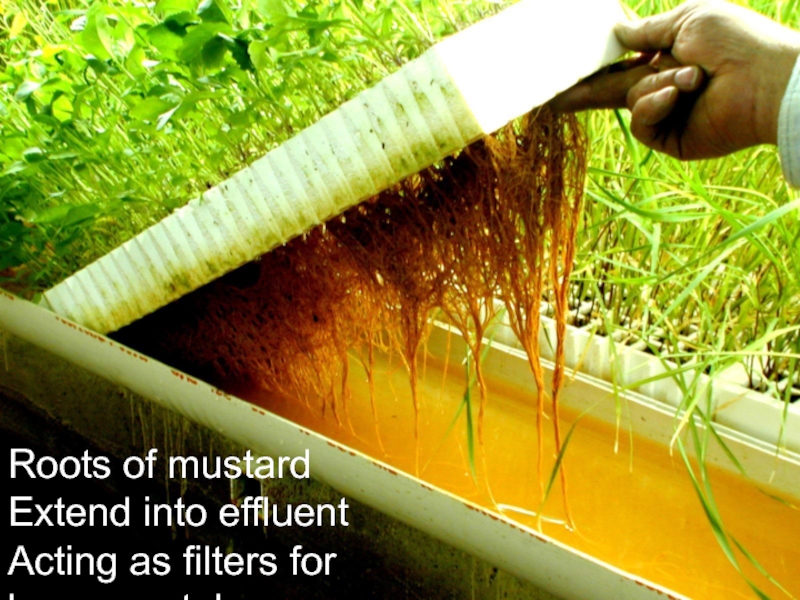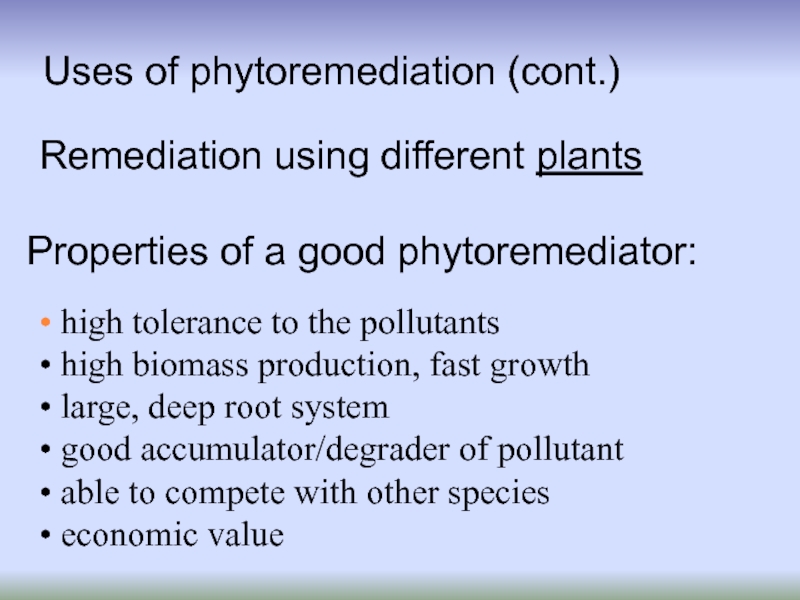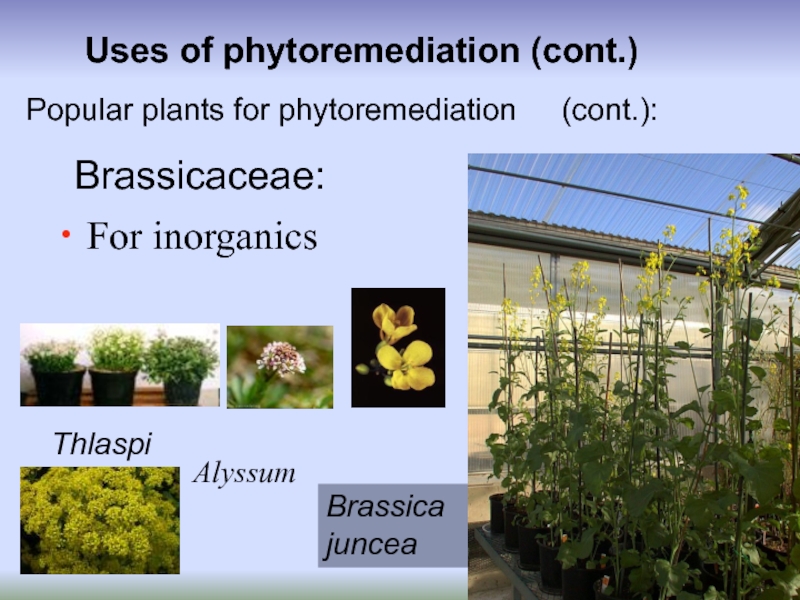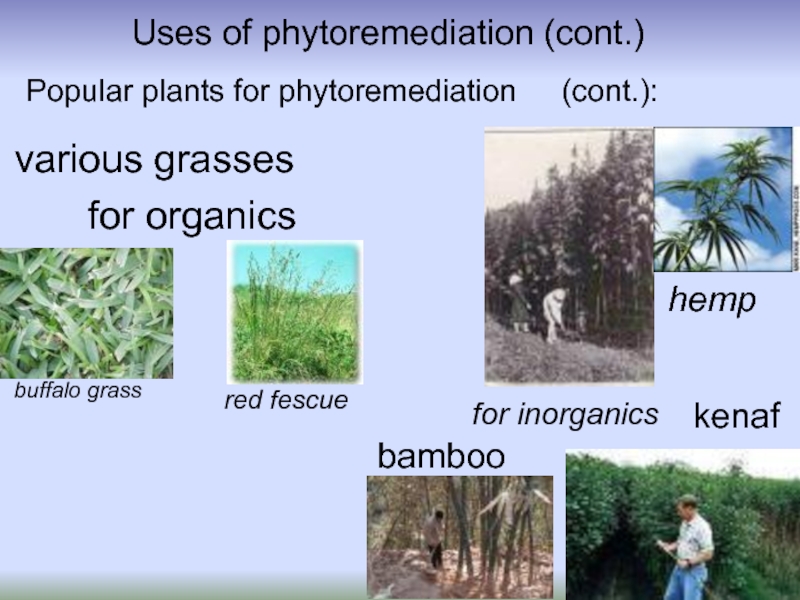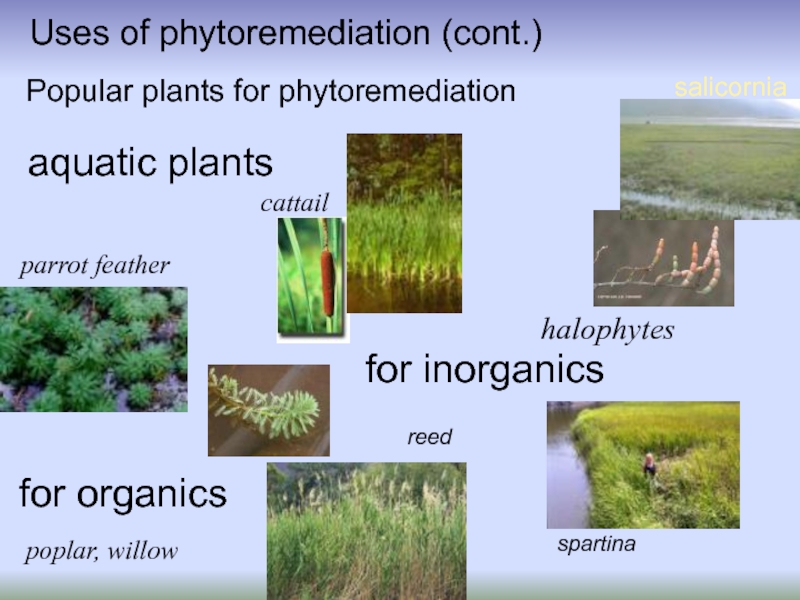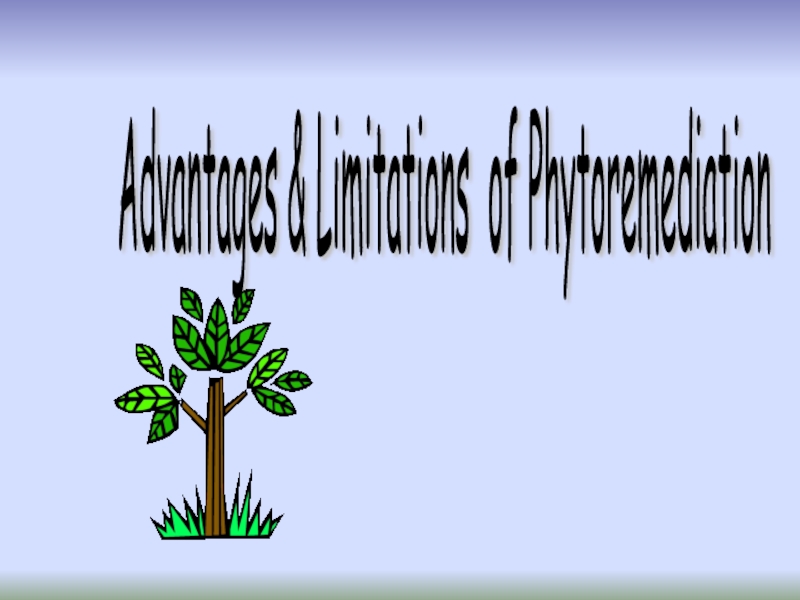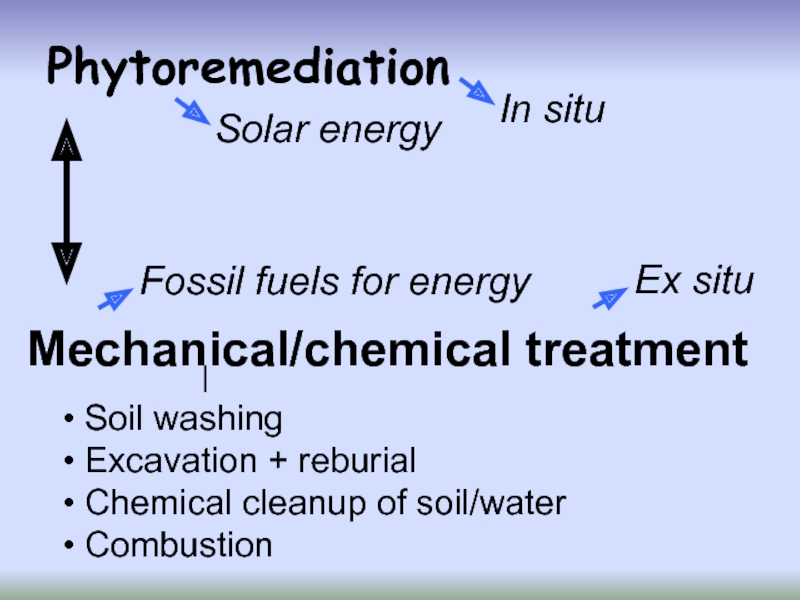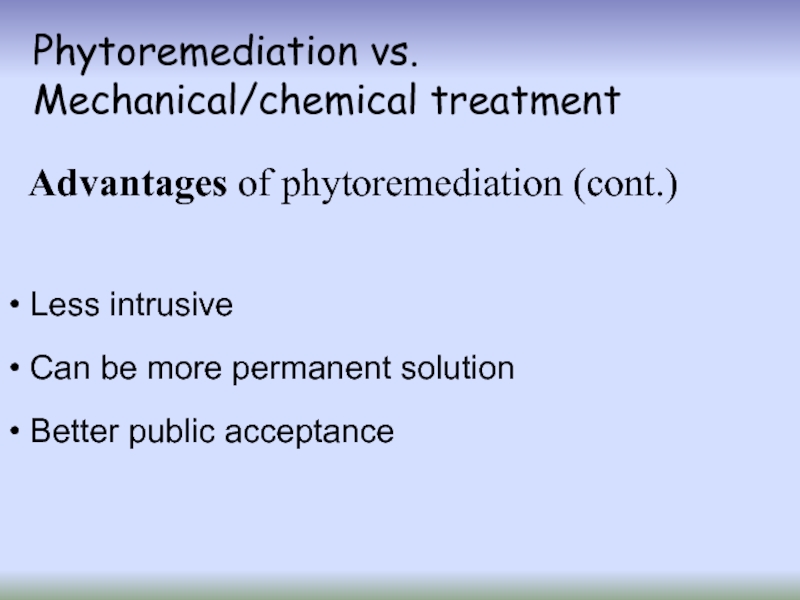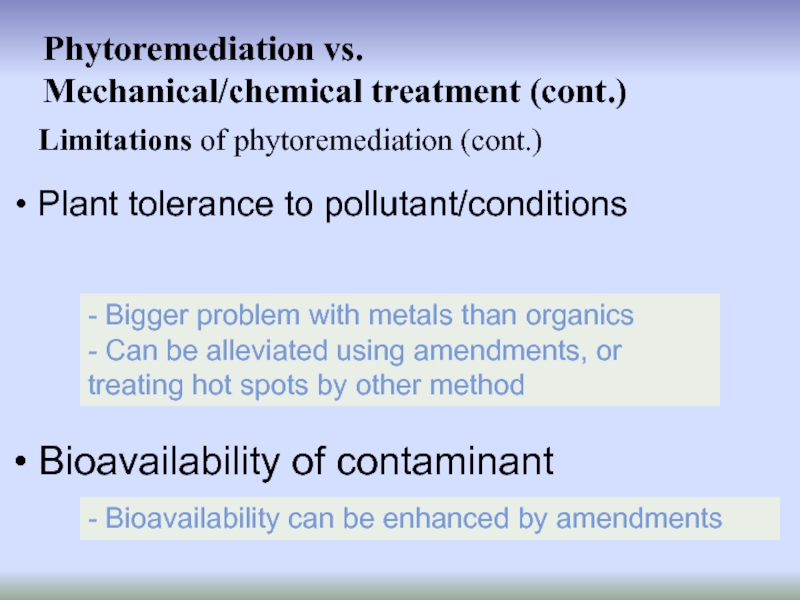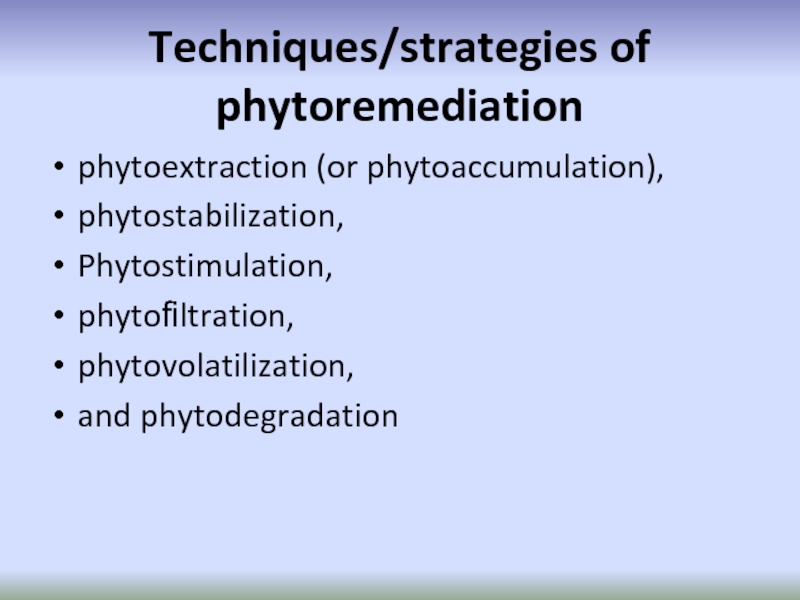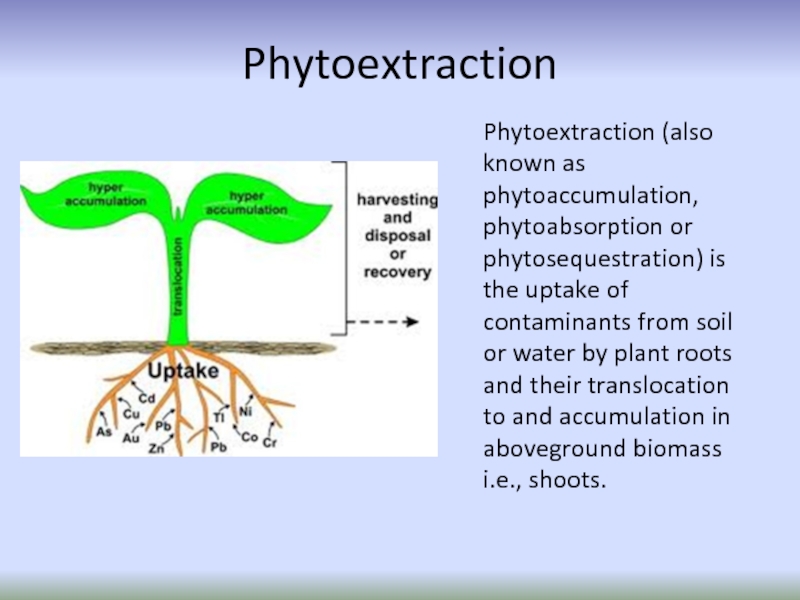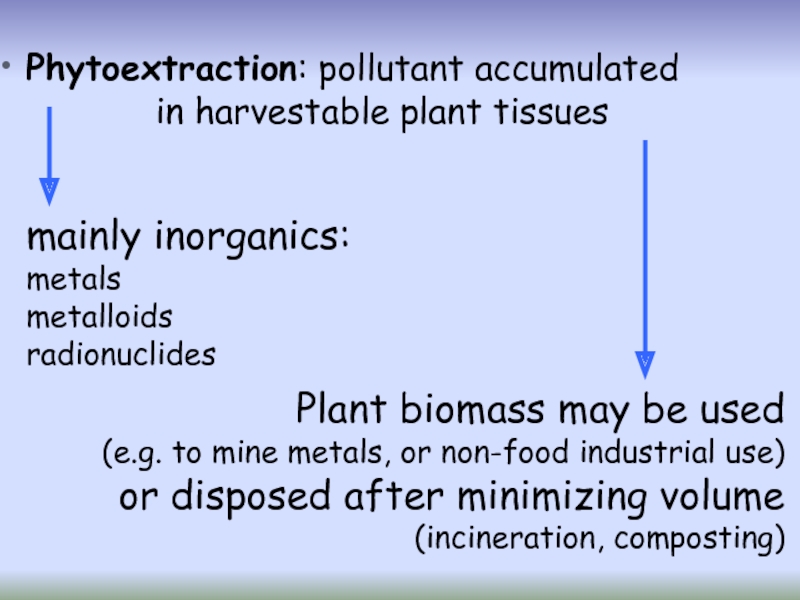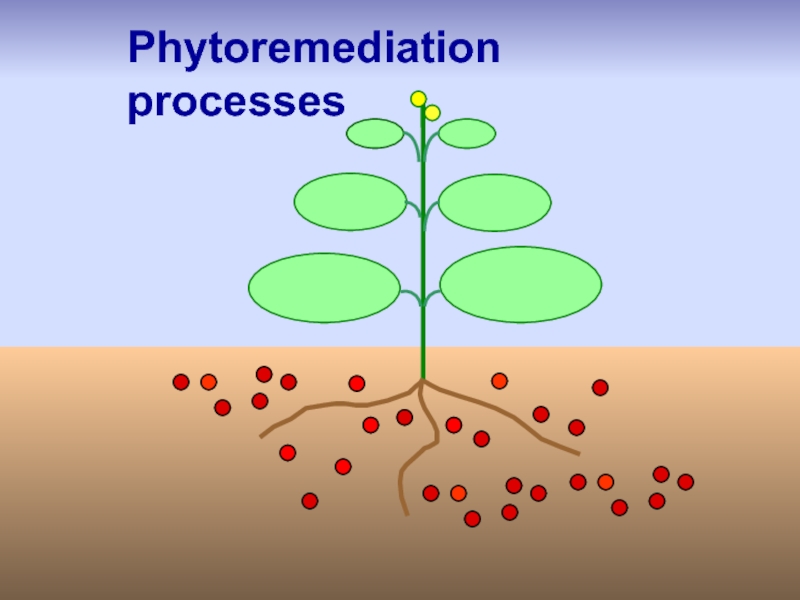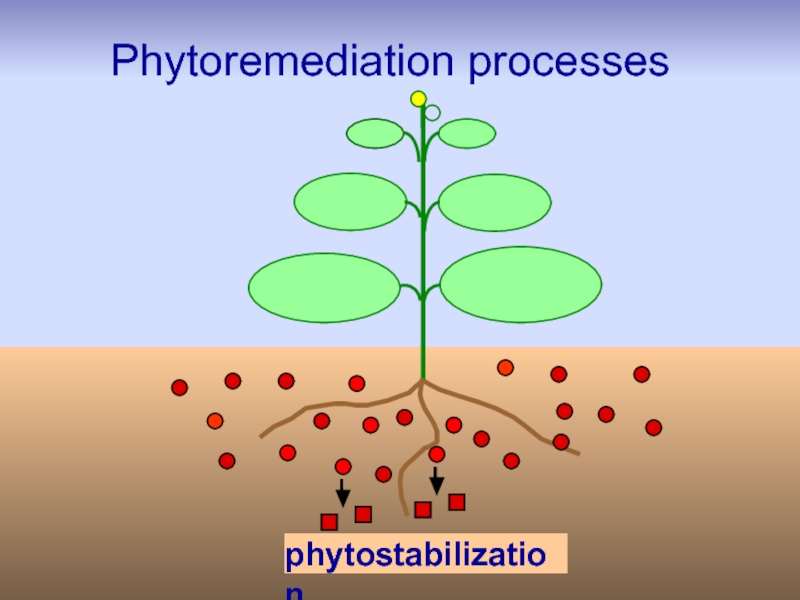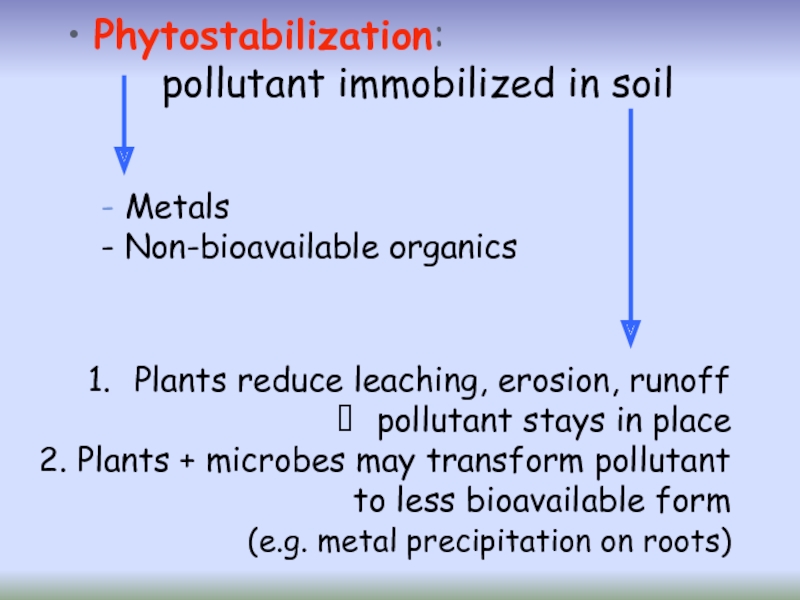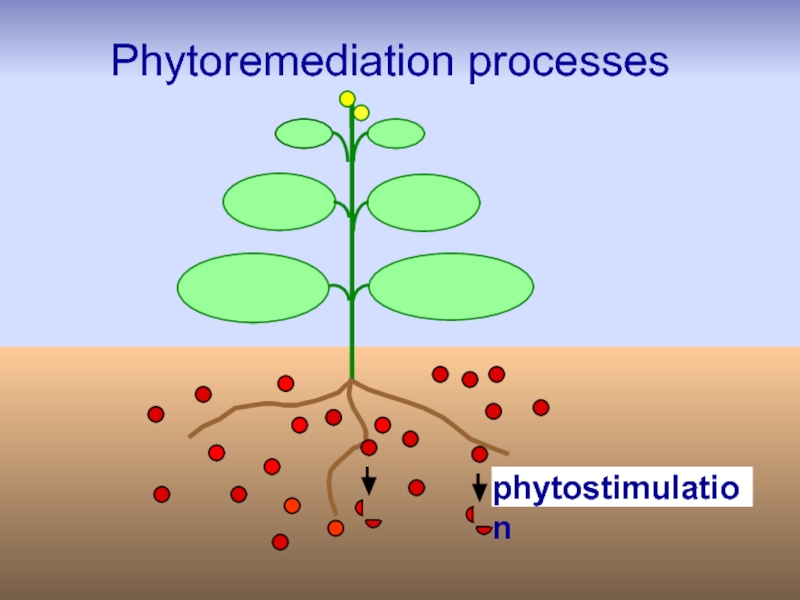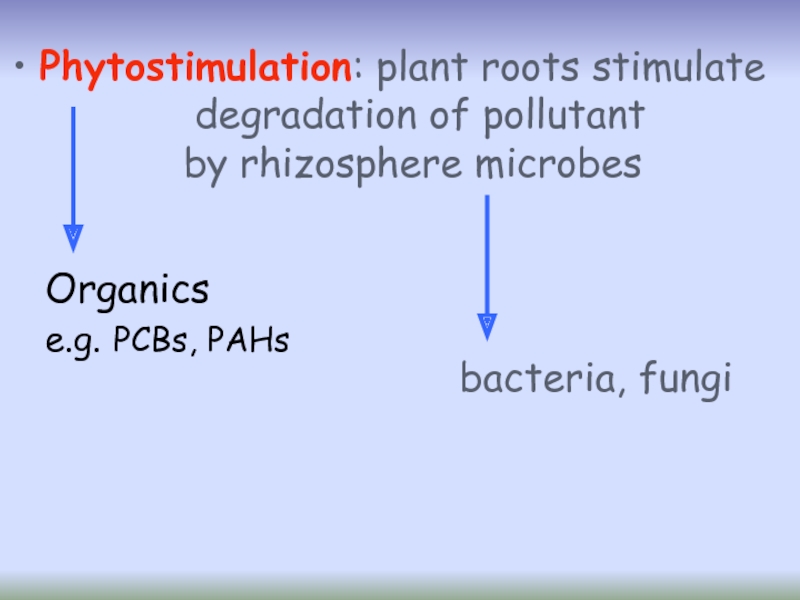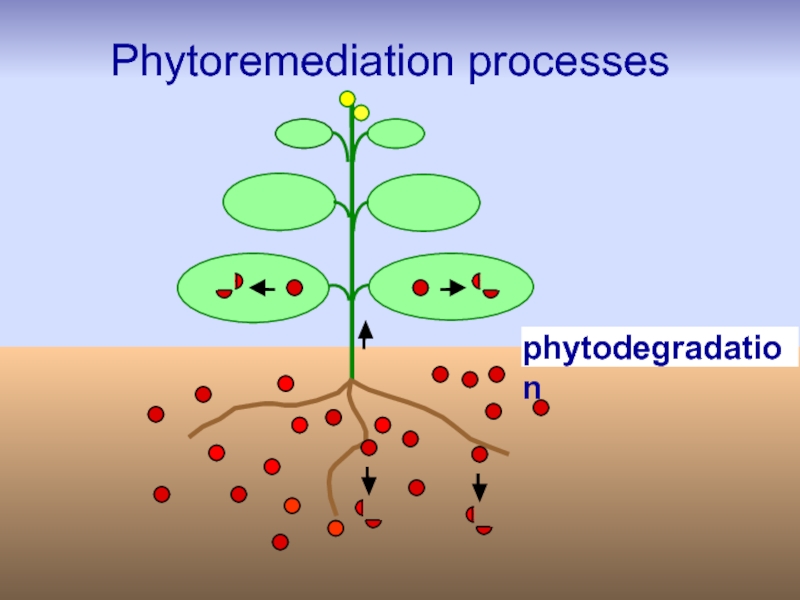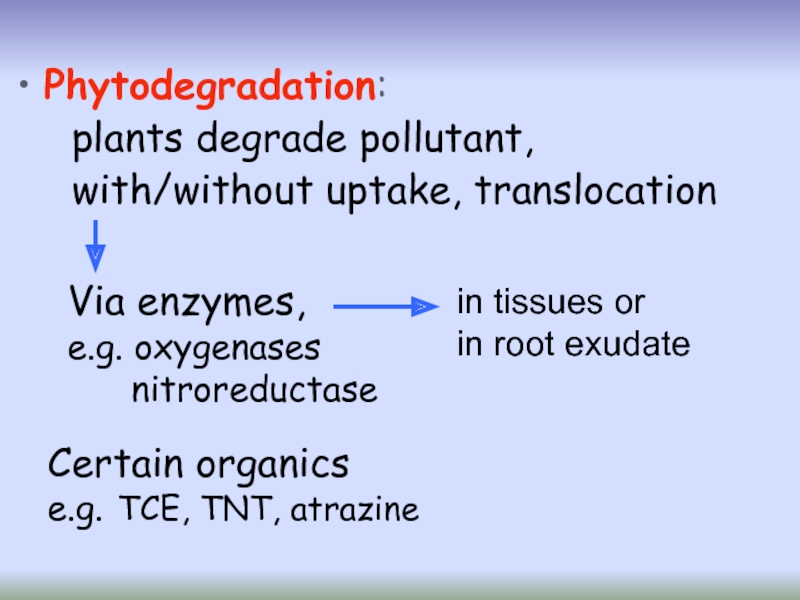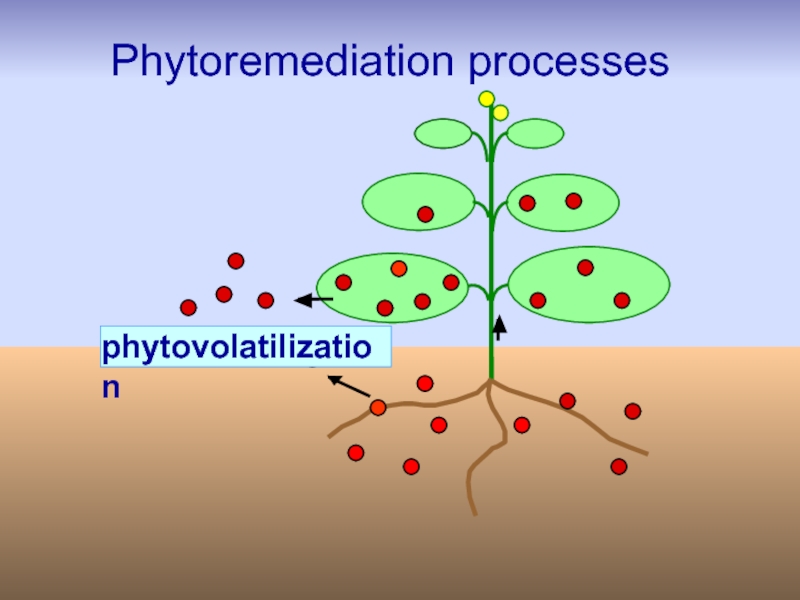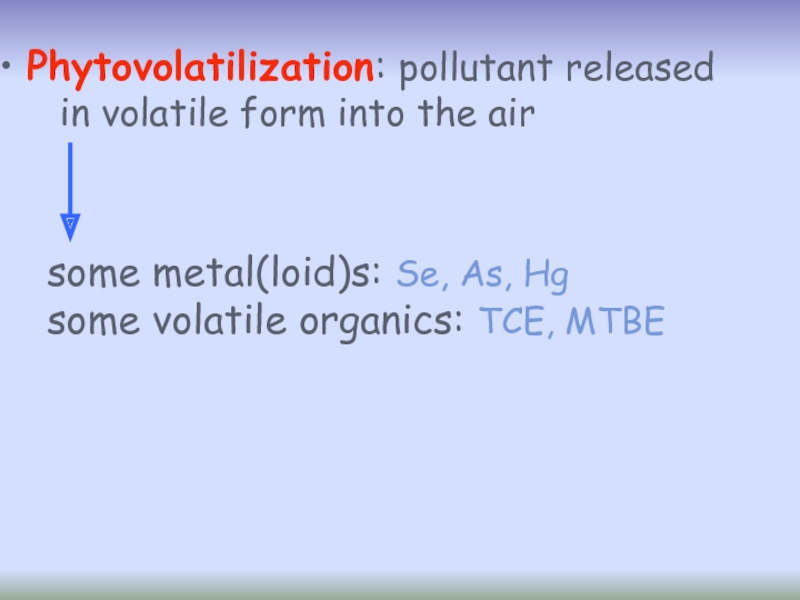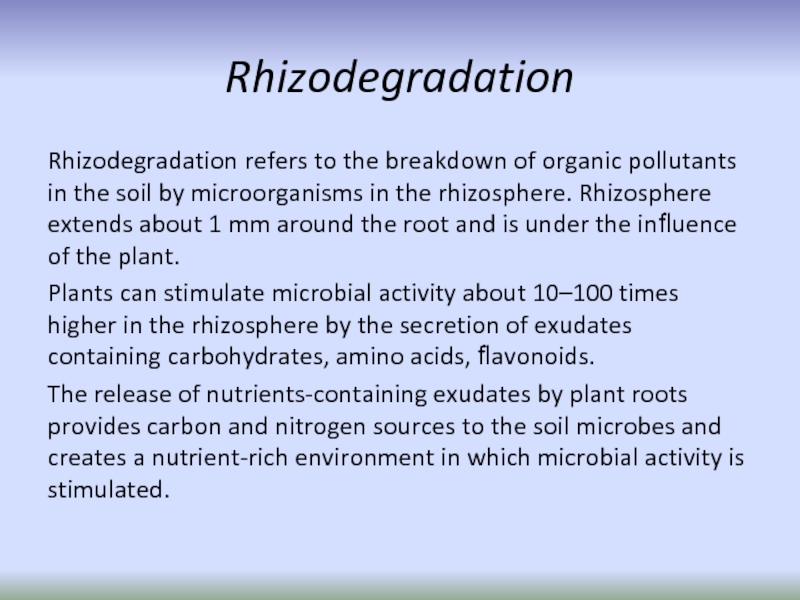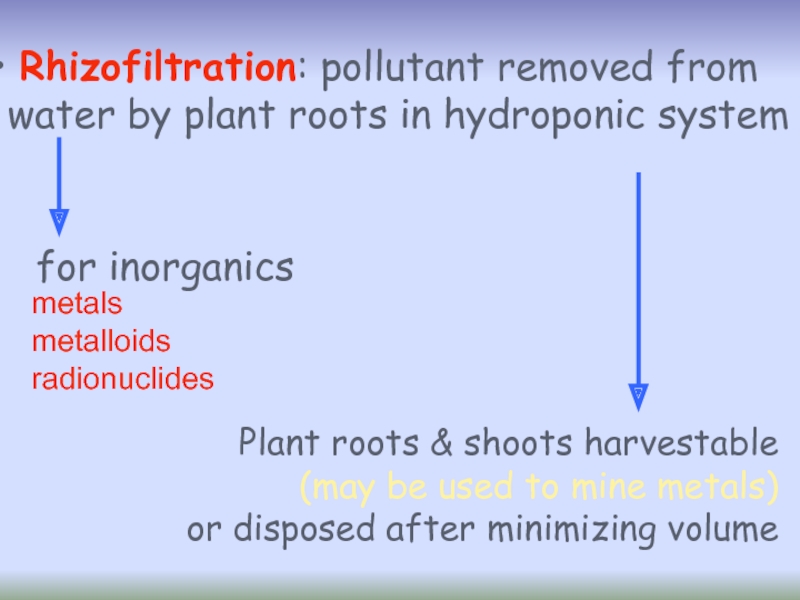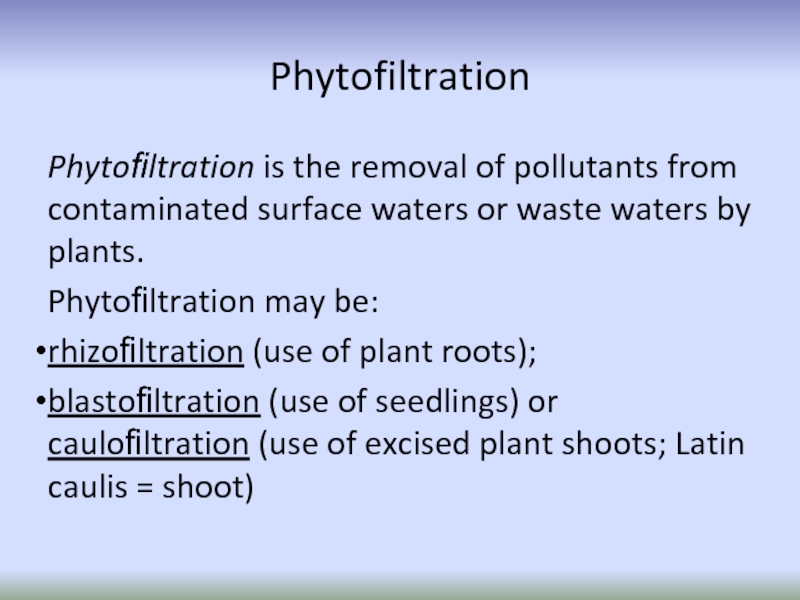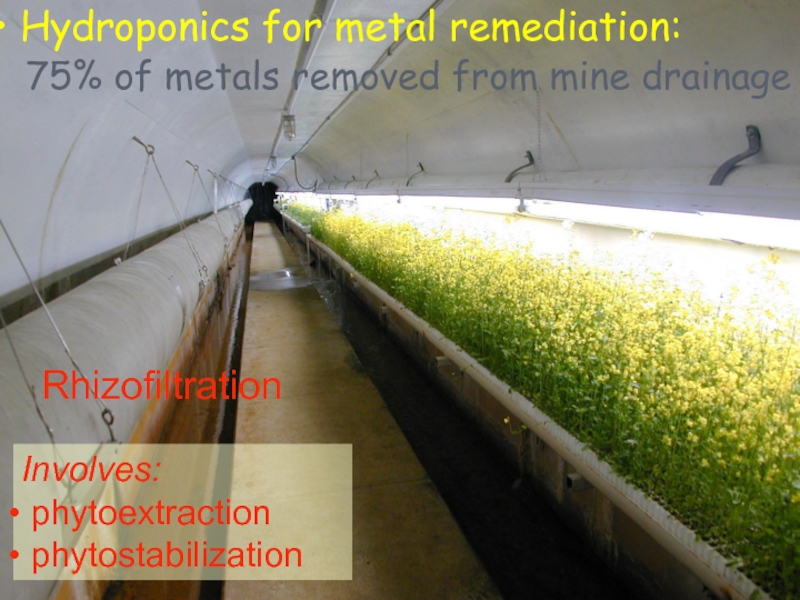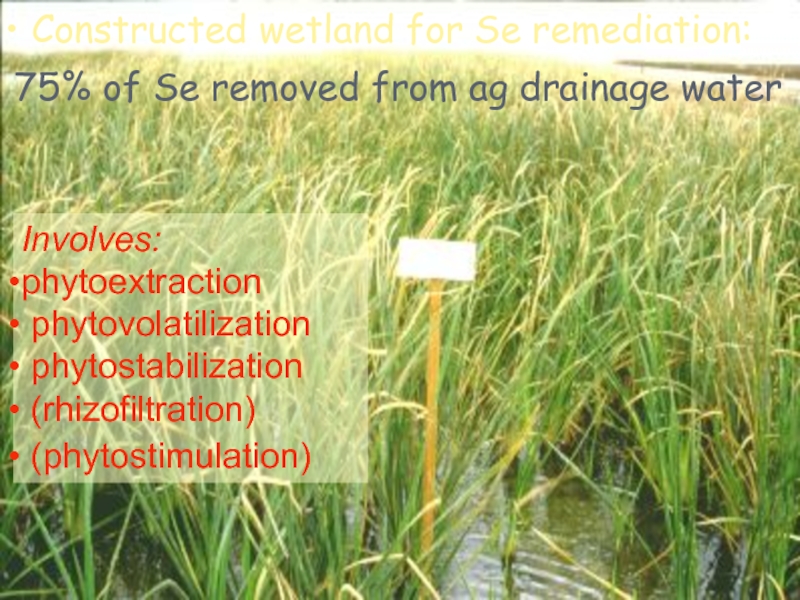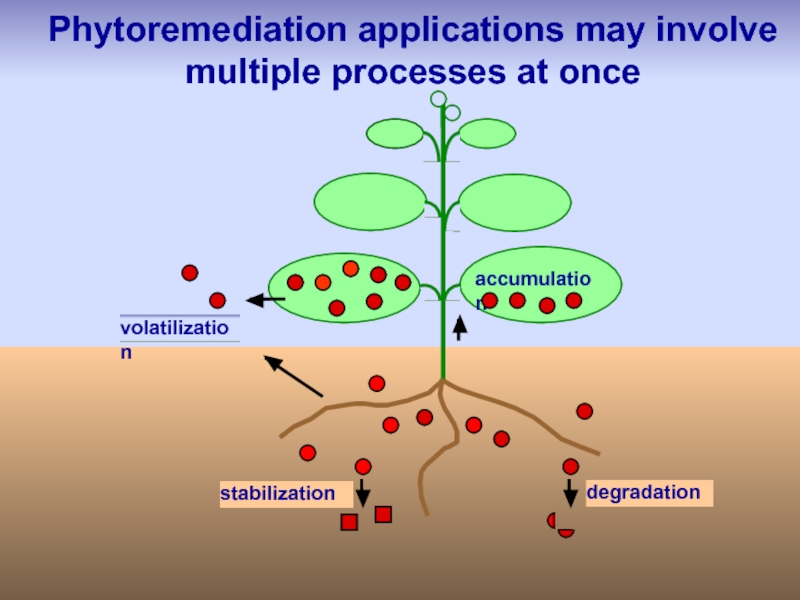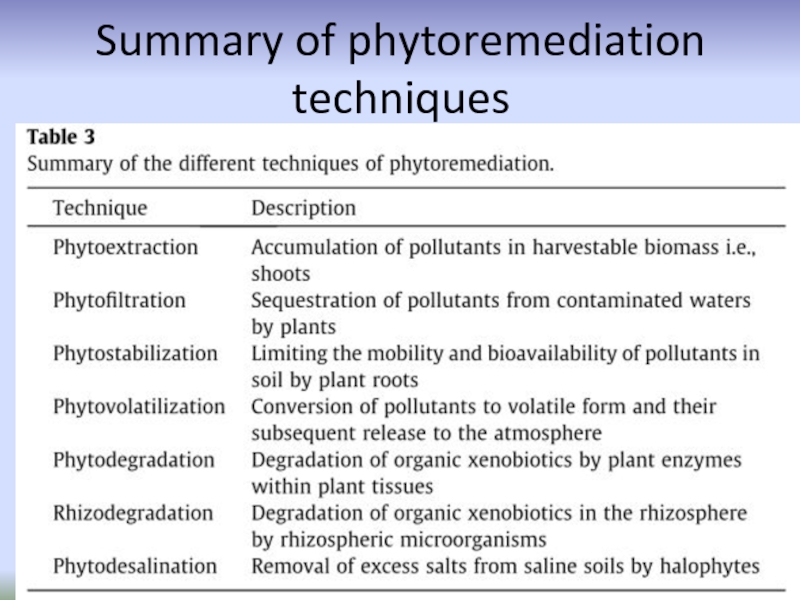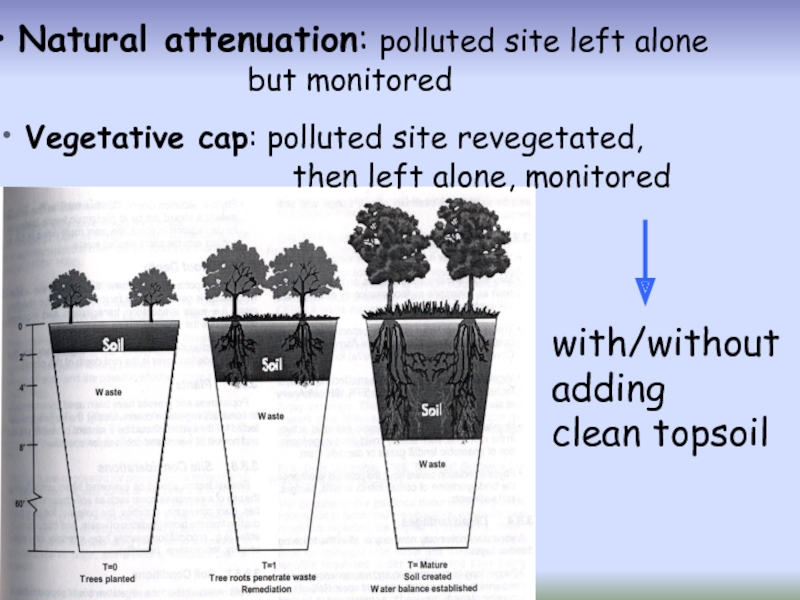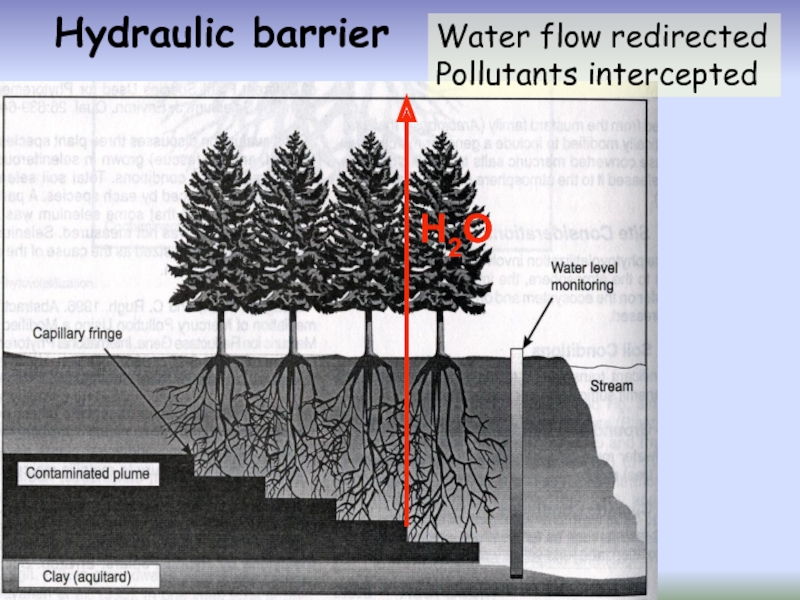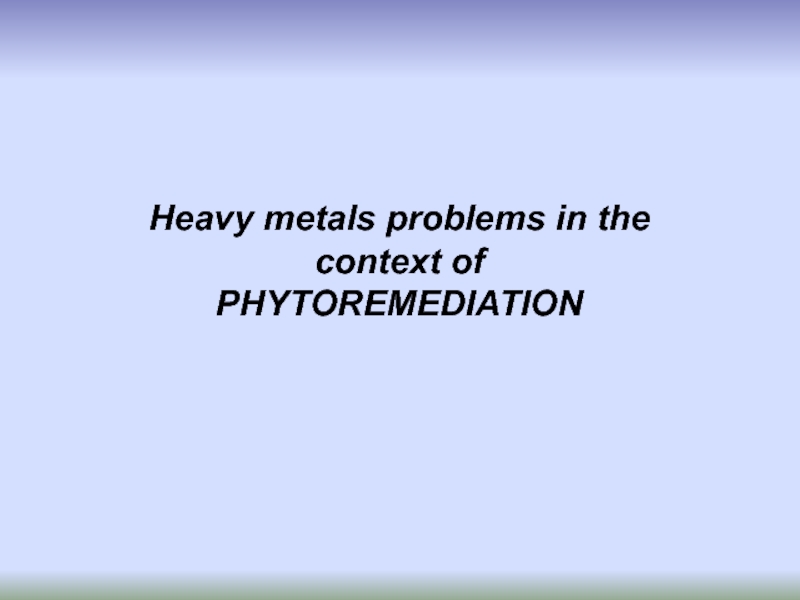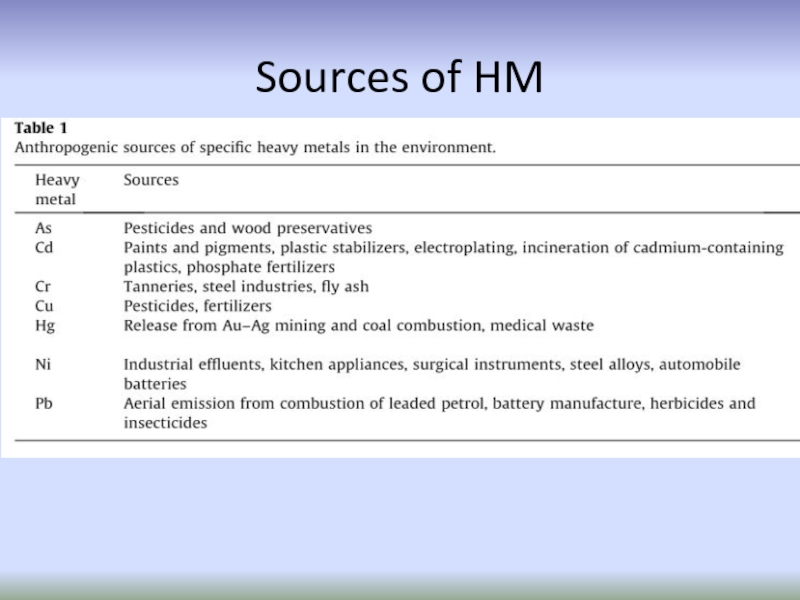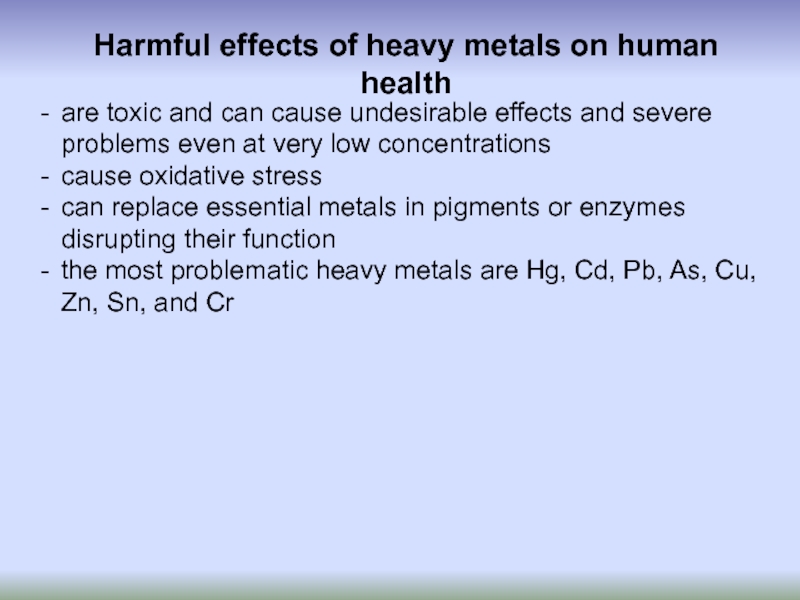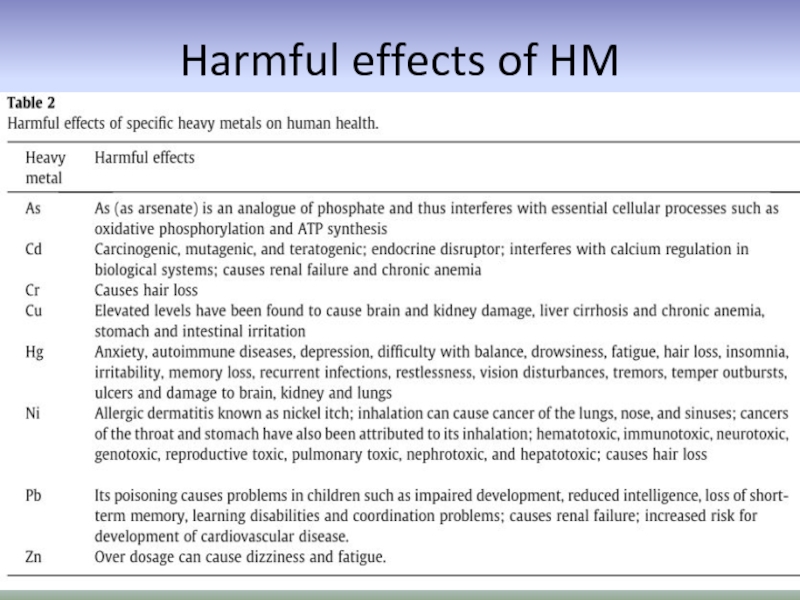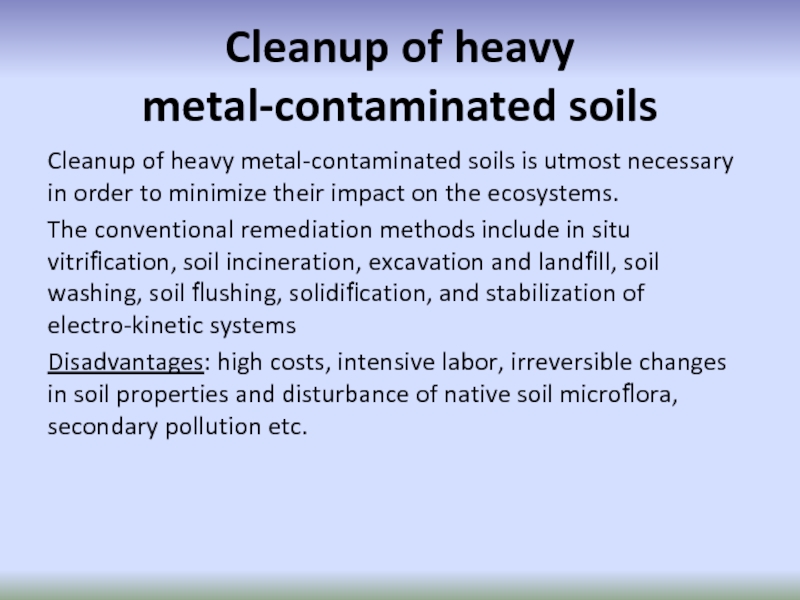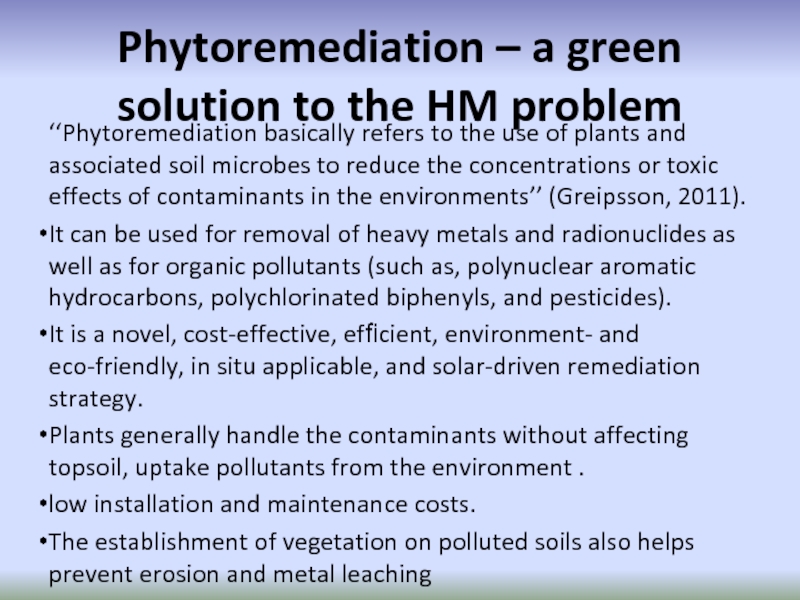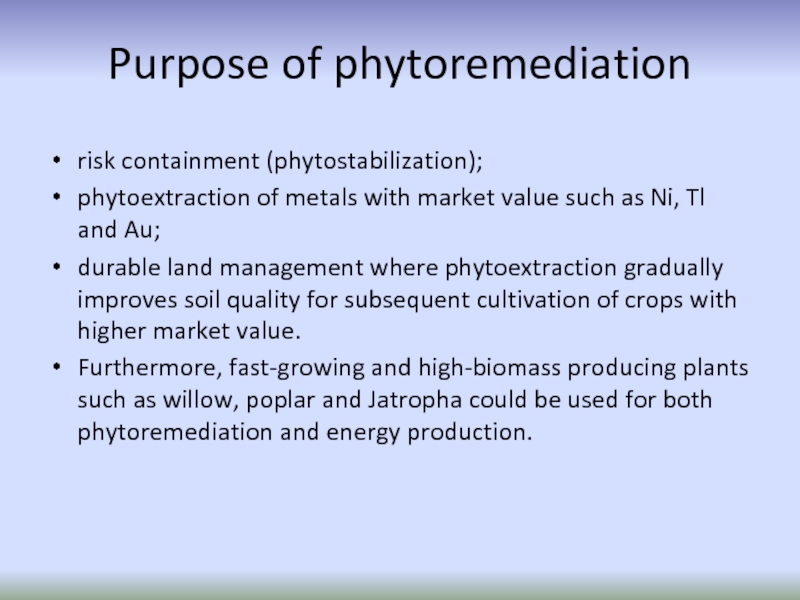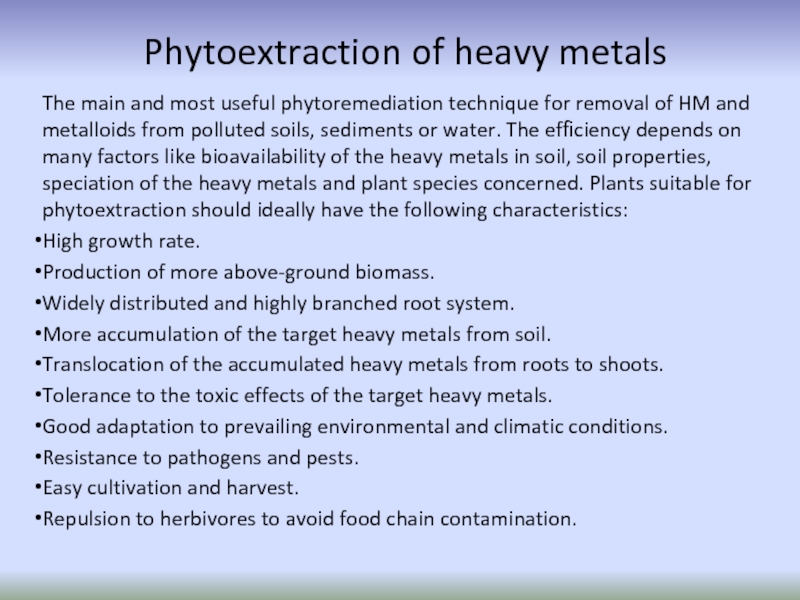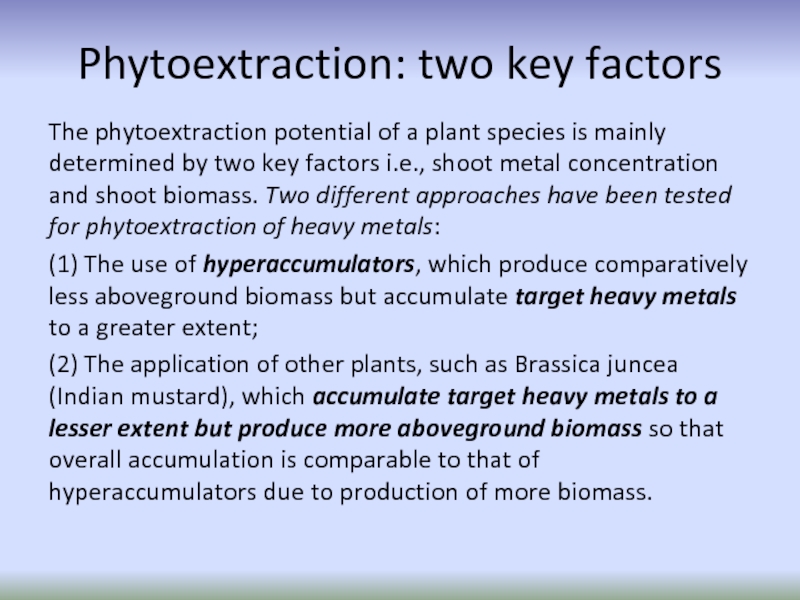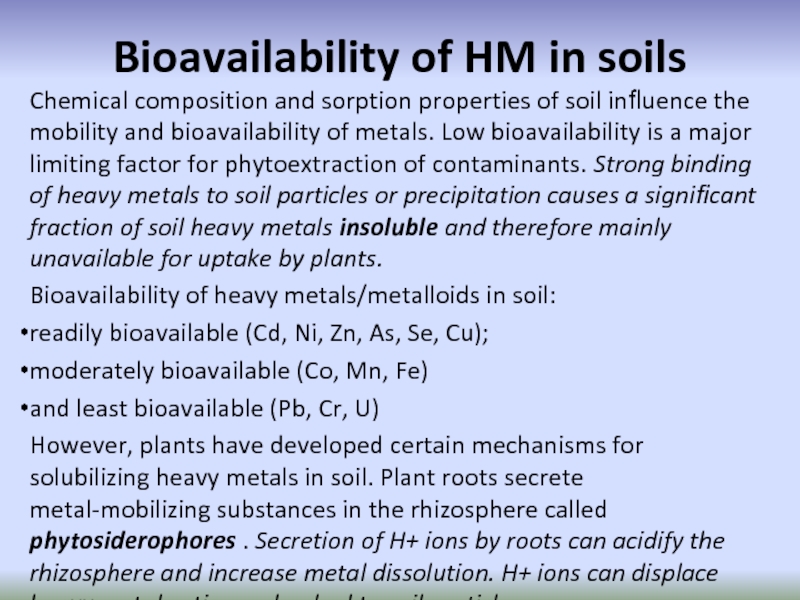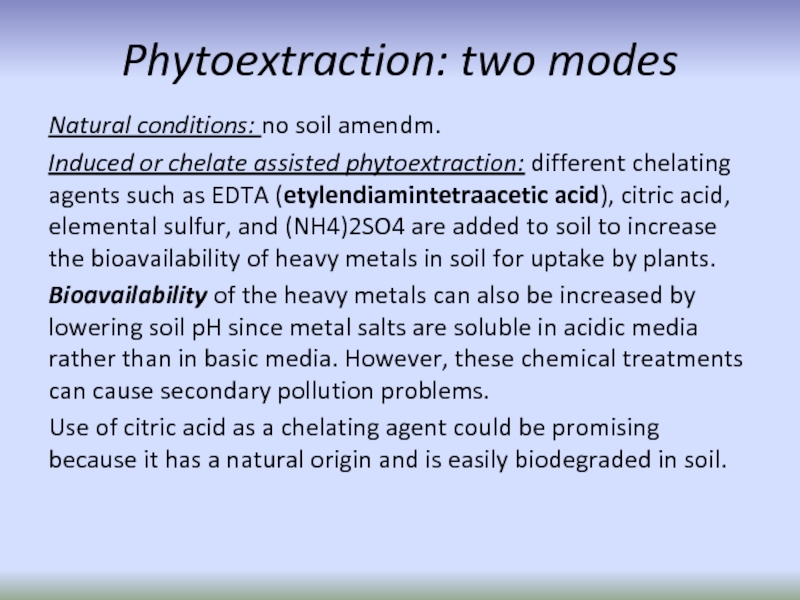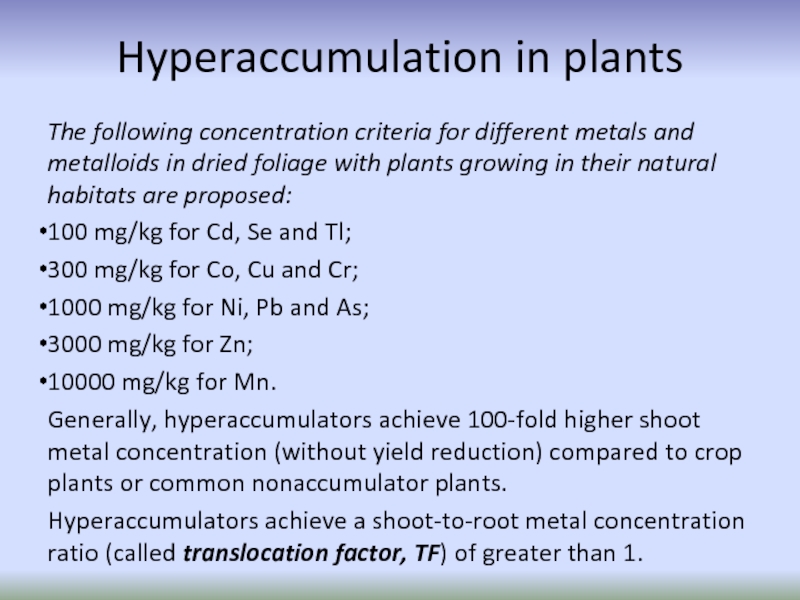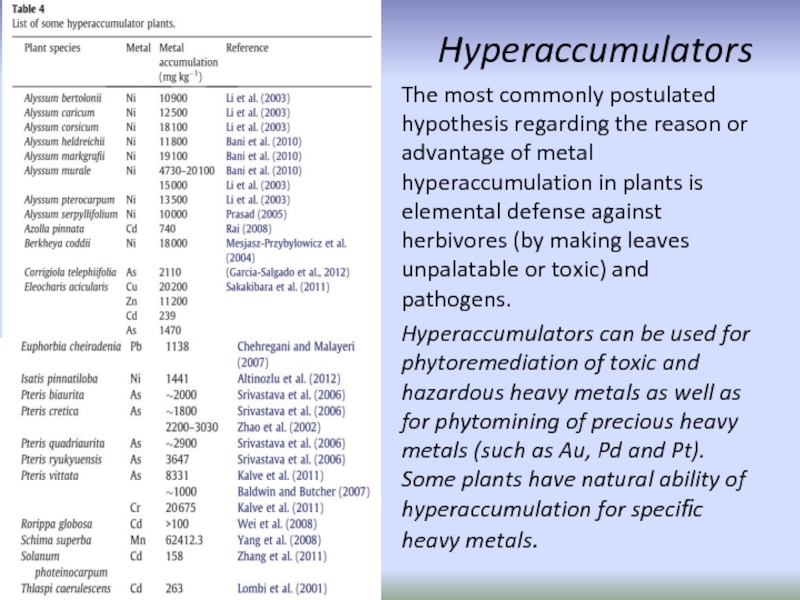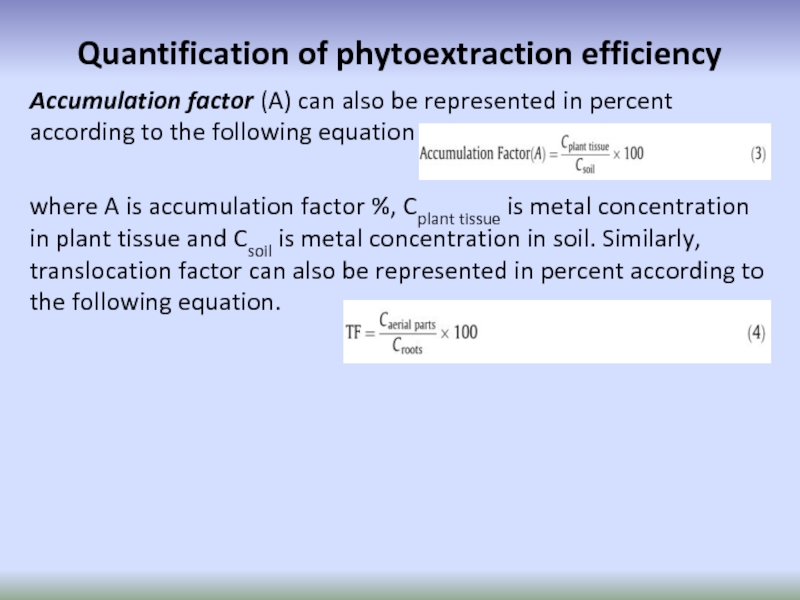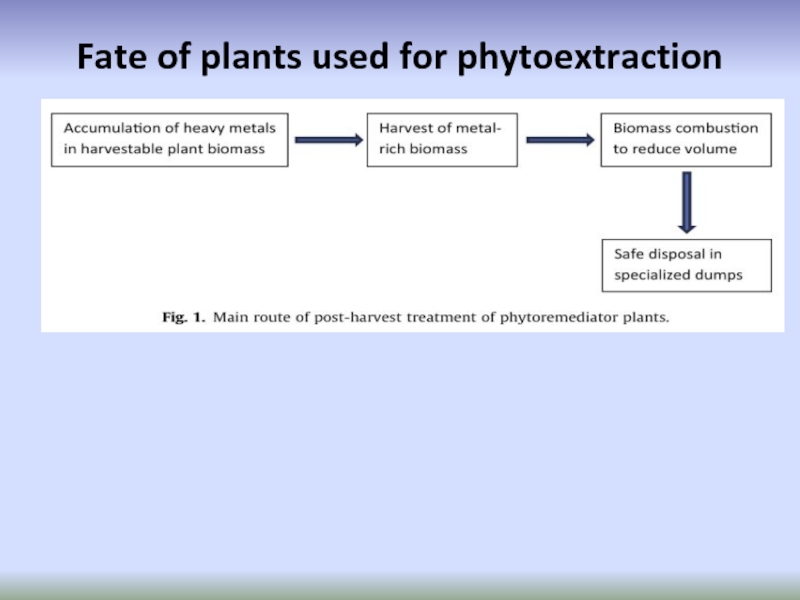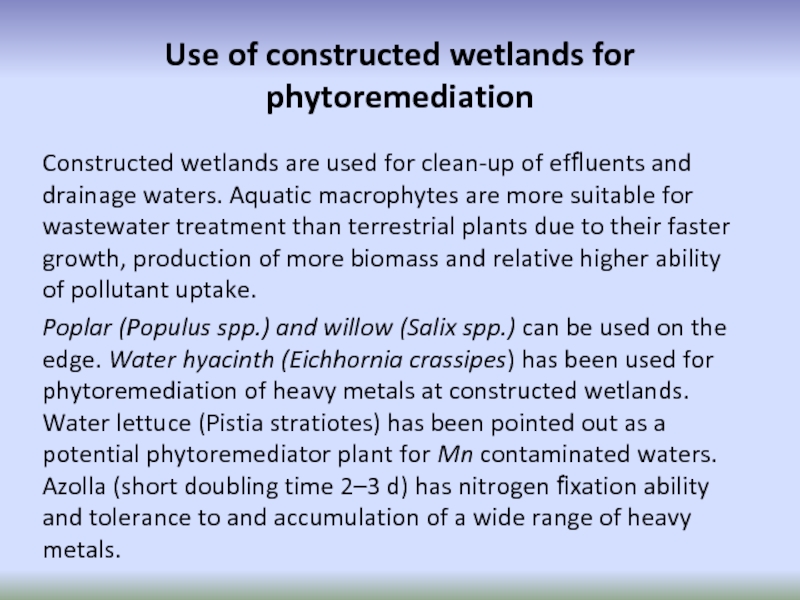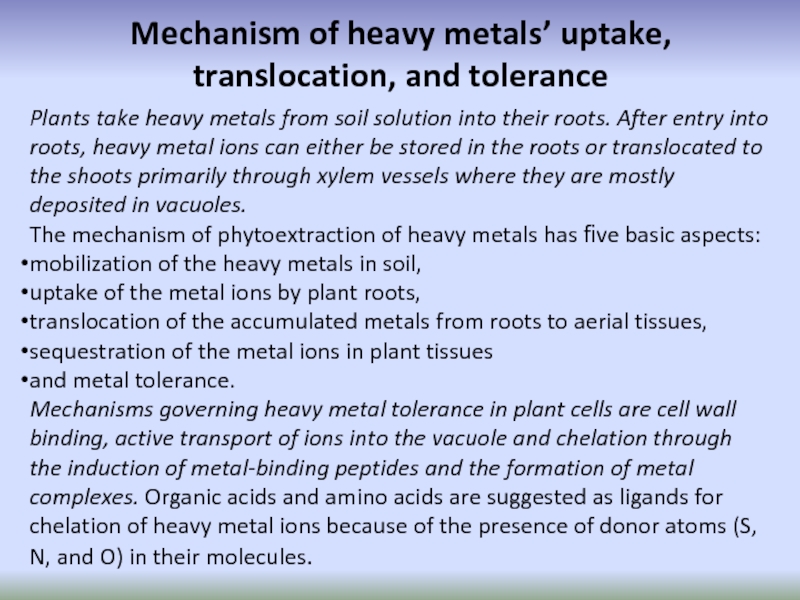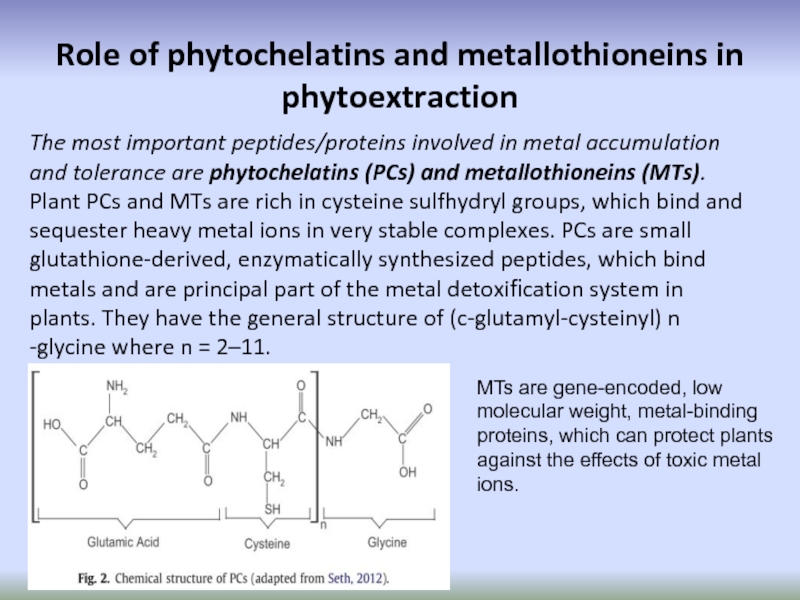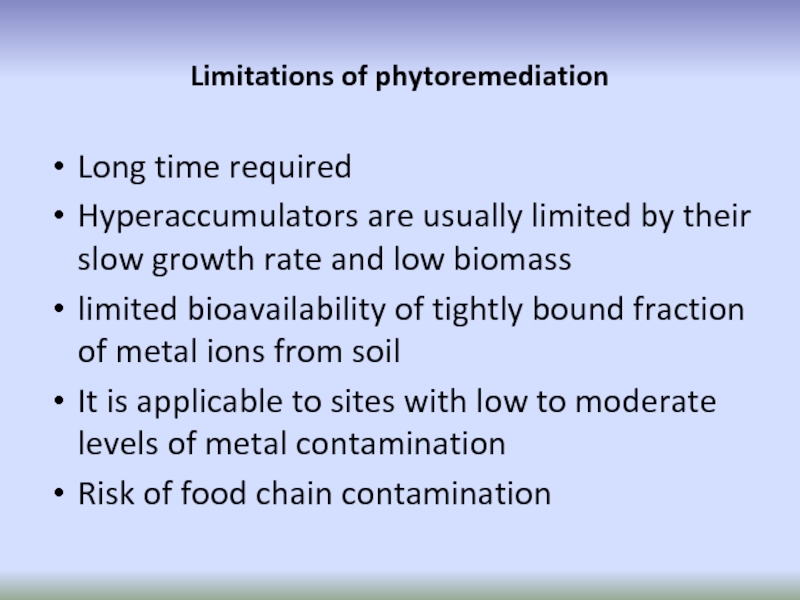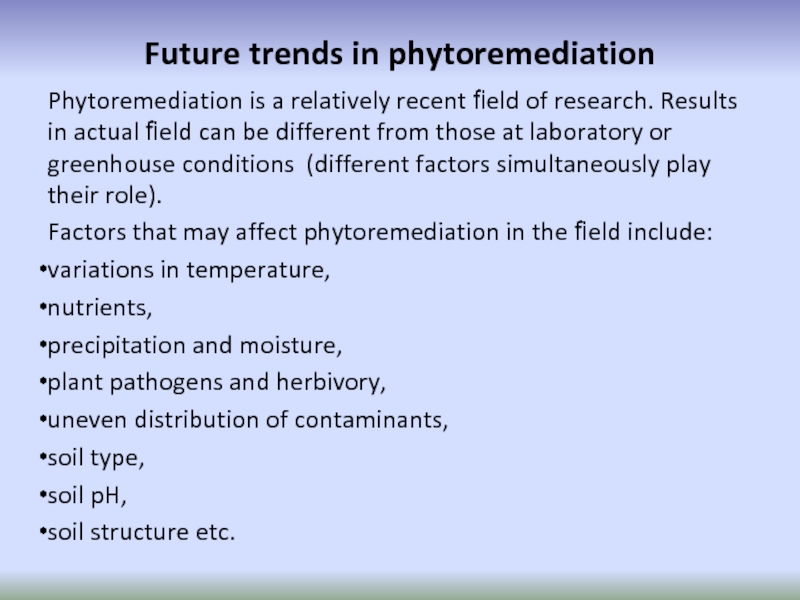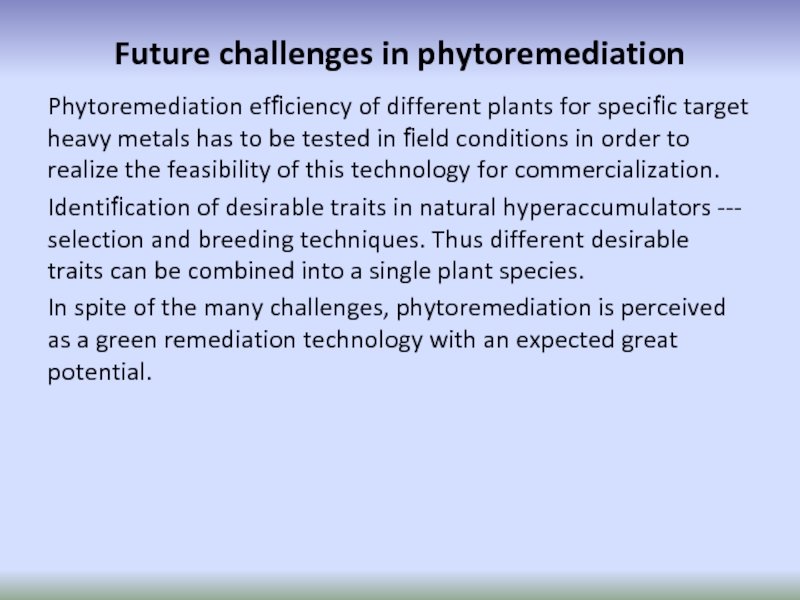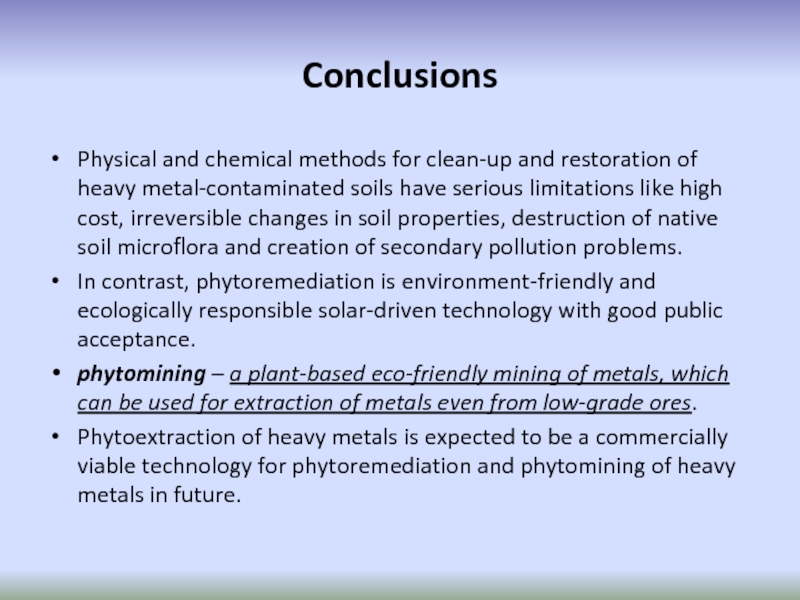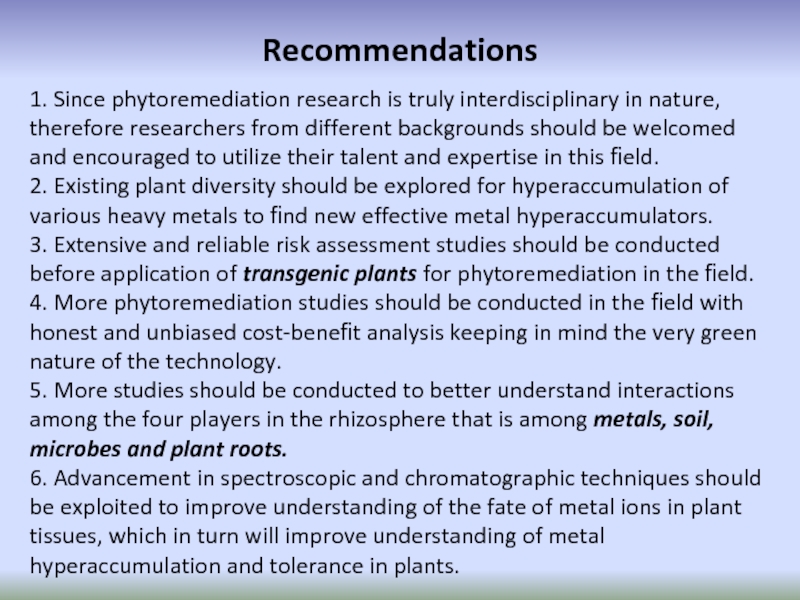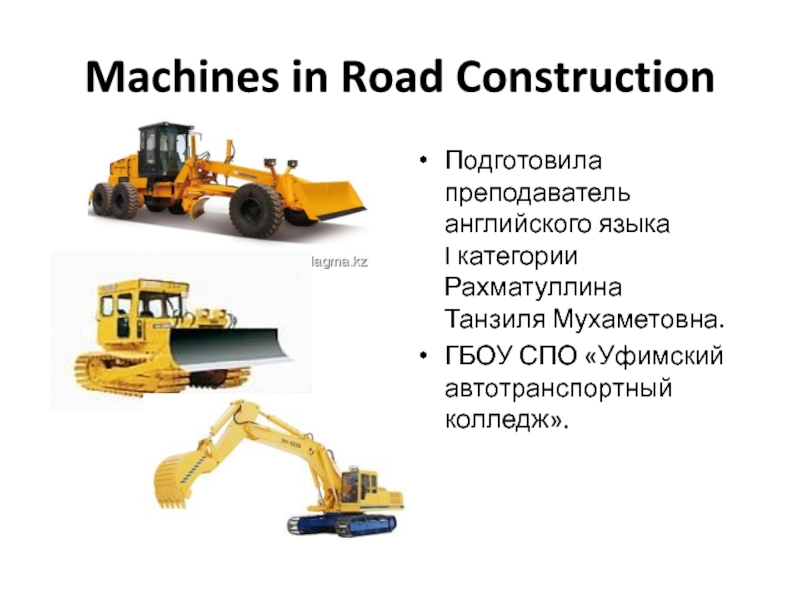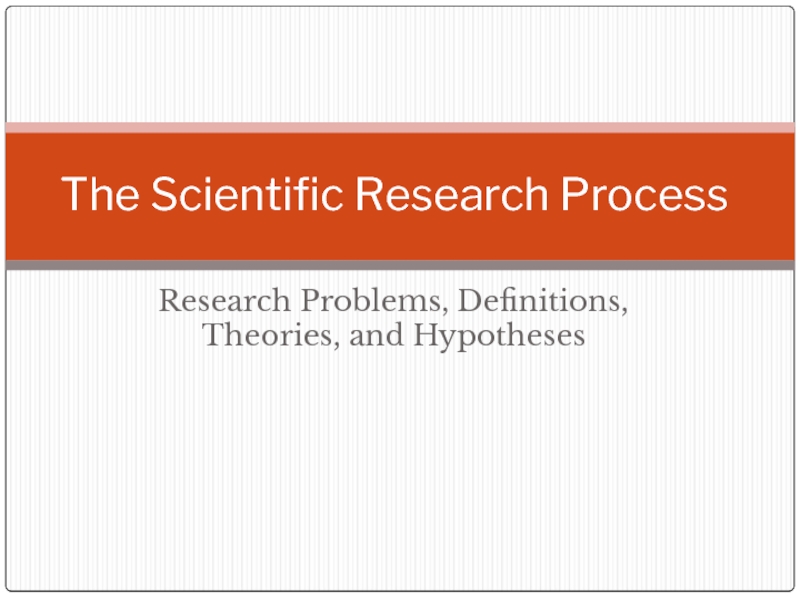- Главная
- Разное
- Дизайн
- Бизнес и предпринимательство
- Аналитика
- Образование
- Развлечения
- Красота и здоровье
- Финансы
- Государство
- Путешествия
- Спорт
- Недвижимость
- Армия
- Графика
- Культурология
- Еда и кулинария
- Лингвистика
- Английский язык
- Астрономия
- Алгебра
- Биология
- География
- Детские презентации
- Информатика
- История
- Литература
- Маркетинг
- Математика
- Медицина
- Менеджмент
- Музыка
- МХК
- Немецкий язык
- ОБЖ
- Обществознание
- Окружающий мир
- Педагогика
- Русский язык
- Технология
- Физика
- Философия
- Химия
- Шаблоны, картинки для презентаций
- Экология
- Экономика
- Юриспруденция
Phytoremediation of heavy metals-concepts and applications презентация
Содержание
- 1. Phytoremediation of heavy metals-concepts and applications
- 2. Uses of phytoremediation air
- 3. Uses of phytoremediation (cont.) inorganics:
- 4. Uses of phytoremediation (cont.) farming
- 5. Hydraulic barrier different systems:
- 6. Vegetative cap different systems:
- 7. Constructed wetlands different systems:
- 8. different systems: hydroponics with polluted wastewater
- 9. Roots of mustard Extend into effluent Acting as filters for heavy metals
- 10. Uses of phytoremediation (cont.) high
- 11. Uses of phytoremediation (cont.) trees
- 12. Uses of phytoremediation (cont.) For
- 13. Uses of phytoremediation (cont.) Popular plants
- 14. Uses of phytoremediation (cont.) Popular plants
- 15. Advantages & Limitations of Phytoremediation
- 16. Phytoremediation Mechanical/chemical treatment Soil washing
- 17. Phytoremediation vs. Mechanical/chemical treatment Cheaper
- 18. Phytoremediation vs. Mechanical/chemical treatment Advantages of
- 19. Limitations of phytoremediation Phytoremediation vs. Mechanical/chemical
- 20. Limitations of phytoremediation (cont.) Phytoremediation vs.
- 21. Limitations of phytoremediation (cont.) Phytoremediation vs.
- 22. So, when choose phytoremediation? Sufficient time
- 23. Techniques/strategies of phytoremediation phytoextraction (or phytoaccumulation),
- 24. Phytoextraction Phytoextraction (also known as phytoaccumulation, phytoabsorption
- 26. Phytoextraction: pollutant accumulated in harvestable plant tissues
- 27. Phytostabilization Phytostabilization or phytoimmobilization is the
- 30. Phytostabilization: pollutant immobilized in soil
- 32. Phytostimulation: plant roots stimulate
- 33. Phytodegradation Phytodegradation is the degradation of
- 35. Phytodegradation: plants degrade pollutant,
- 36. Phytovolatilization Phytovolatilization is the uptake of
- 38. Phytovolatilization: pollutant released in volatile form into the air
- 39. Rhizodegradation Rhizodegradation refers to the breakdown of
- 41. Rhizofiltration: pollutant removed from water
- 42. Phytofiltration Phytofiltration is the removal of
- 43. Rhizofiltration Hydroponics for metal remediation: 75%
- 44. Constructed wetland for Se remediation: Involves:
- 45. Phytodesalination Phytodesalination refers to the use
- 47. Summary of phytoremediation techniques
- 48. Natural attenuation: polluted site left alone
- 49. Hydraulic barrier Water flow redirected Pollutants intercepted
- 50. Heavy metals problems in the context of PHYTOREMEDIATION
- 51. heavy metals originate from extraction of ores
- 52. Anthropogenic sources Sources of heavy metals in
- 53. Sources of HM
- 54. Harmful effects of heavy metals on human
- 55. Harmful effects of HM
- 56. Cleanup of heavy metal-contaminated soils Cleanup of
- 57. Phytoremediation – a green solution to the
- 58. Purpose of phytoremediation risk containment (phytostabilization);
- 59. Phytoextraction of heavy metals The main
- 60. Phytoextraction: two key factors The phytoextraction
- 61. Bioavailability of HM in soils Chemical composition
- 62. Phytoextraction: two modes Natural conditions: no soil
- 63. Metallophytes Metallophytes are plants that are specifically
- 64. Hyperaccumulation in plants The following concentration criteria
- 65. Hyperaccumulators The most commonly postulated hypothesis regarding
- 66. Quantification of phytoextraction efficiency Bioconcentration factor indicates
- 67. Quantification of phytoextraction efficiency Accumulation factor (A)
- 68. Fate of plants used for phytoextraction
- 69. Phytomining Advantages: - can be combusted to
- 70. Use of constructed wetlands for phytoremediation Constructed
- 71. Mechanism of heavy metals’ uptake, translocation, and
- 72. Role of phytochelatins and metallothioneins in phytoextraction
- 73. Limitations of phytoremediation Long time required
- 74. Future trends in phytoremediation Phytoremediation is a
- 75. Future challenges in phytoremediation Phytoremediation efficiency of
- 76. Interdisciplinary nature of phytoremediation research
- 77. Conclusions Physical and chemical methods for clean-up
- 78. Recommendations 1. Since phytoremediation research is truly
Слайд 1Phytoremediation of heavy metals—Concepts and applications Oleksandr Kovrov, PhD, Associate Professor of the
Слайд 2 Uses of phytoremediation
air
soils, sediments
groundwater
wastewater streams
- industrial
- agricultural
- municipal, sewage
Remediation of different media:
Слайд 3 Uses of phytoremediation (cont.)
inorganics:
- metals (Pb, Cd, Zn, Cr,
- metalloids (Se, As)
- “nutrients” (K, P, N, S)
- radionuclides (Cs, U)
Remediation of different pollutants:
organics:
- PCBs
- PAHs
- TCE
TNT
MTBE
- pesticides
- petroleum
hydrocarbons
Etc.
Слайд 4 Uses of phytoremediation (cont.)
farming polluted soil
irrigation with polluted
letting trees tap into groundwater
letting plants filter water streams
constructed wetlands, hydroponics
Remediation using different systems:
Слайд 10 Uses of phytoremediation (cont.)
high tolerance to the pollutants
high
large, deep root system
good accumulator/degrader of pollutant
able to compete with other species
economic value
Properties of a good phytoremediator:
Remediation using different plants
Слайд 11 Uses of phytoremediation (cont.)
trees
Popular plants for phytoremediation
various organics
metals
poplar
willow
gum tree
yellow
Слайд 12 Uses of phytoremediation (cont.)
For inorganics
Popular plants for phytoremediation
grasses
(cont.):
Brassica juncea
Alyssum
Thlaspi
Brassicaceae:
Слайд 13 Uses of phytoremediation (cont.)
Popular plants for phytoremediation
(cont.):
hemp
kenaf
bamboo
various grasses
red fescue
buffalo
for organics
for inorganics
Слайд 14 Uses of phytoremediation (cont.)
Popular plants for phytoremediation
parrot feather
poplar, willow
spartina
halophytes
salicornia
reed
aquatic plants
cattail
for organics
for inorganics
Слайд 16Phytoremediation
Mechanical/chemical treatment
Soil washing
Excavation + reburial
Chemical cleanup of soil/water
Слайд 17Phytoremediation vs.
Mechanical/chemical treatment
Cheaper
Advantages of phytoremediation
~10 - 100x
Excavation & reburial:
Revegetation: ~$20,000/acre
Слайд 18Phytoremediation vs.
Mechanical/chemical treatment
Advantages of phytoremediation (cont.)
Less intrusive
Can be
Better public acceptance
Слайд 19Limitations of phytoremediation
Phytoremediation vs.
Mechanical/chemical treatment (cont.)
Can be slower
Limited by
- Metabolic breakdown (organics): fairly fast
- Filter action by plants: fast (days)
Accumulation in plant tissue: slow
e.g. metals: average 15 yrs to clean up site
(< 1yr)
Слайд 20Limitations of phytoremediation (cont.)
Phytoremediation vs.
Mechanical/chemical treatment (cont.)
Limited root depth
Trees
Слайд 21Limitations of phytoremediation (cont.)
Phytoremediation vs.
Mechanical/chemical treatment (cont.)
Plant tolerance to
Bioavailability of contaminant
- Bigger problem with metals than organics
- Can be alleviated using amendments, or treating hot spots by other method
- Bioavailability can be enhanced by amendments
Слайд 22So, when choose phytoremediation?
Sufficient time available
Pollution shallow enough
For very large quantities of mildly
contaminated substrate:
phytoremediation only cost-effective option
Note: Phyto may be used in conjunction with
other remediation methods
$$ limited
Слайд 23Techniques/strategies of phytoremediation
phytoextraction (or phytoaccumulation),
phytostabilization,
Phytostimulation,
phytofiltration,
phytovolatilization,
and phytodegradation
Слайд 24Phytoextraction
Phytoextraction (also known as phytoaccumulation, phytoabsorption or phytosequestration) is the uptake
Слайд 27Phytostabilization
Phytostabilization or phytoimmobilization is the use of certain plants for
is used to reduce the mobility and bioavailability of pollutants in the environment, thus preventing their migration to groundwater or their entry into the food chain.
Plants can immobilize heavy metals in soils through:
sorption by roots,
precipitation,
complexation or metal valence reduction in rhizosphere etc.
Слайд 33Phytodegradation
Phytodegradation is the degradation of organic pollutants by plants with
Plants can accumulate organic xenobiotics from polluted environments and detoxify them through their metabolic activities (‘‘Green Liver’’ for the biosphere).
Limitations:
Heavy metals are non-biodegradable.
Слайд 35 Phytodegradation:
plants degrade pollutant,
with/without uptake, translocation
Certain organics
e.g. TCE, TNT,
Слайд 36Phytovolatilization
Phytovolatilization is the uptake of pollutants from soil by plants,
Disadvantage:
use is limited by the fact that it does not remove the pollutant completely; only it is transferred from one segment (soil) to another (atmosphere) from where it can be redeposited.
Слайд 39Rhizodegradation
Rhizodegradation refers to the breakdown of organic pollutants in the soil
Plants can stimulate microbial activity about 10–100 times higher in the rhizosphere by the secretion of exudates containing carbohydrates, amino acids, flavonoids.
The release of nutrients-containing exudates by plant roots provides carbon and nitrogen sources to the soil microbes and creates a nutrient-rich environment in which microbial activity is stimulated.
Слайд 41 Rhizofiltration: pollutant removed from
water by plant roots in hydroponic
metals
metalloids
radionuclides
Слайд 42Phytofiltration
Phytofiltration is the removal of pollutants from contaminated surface waters
Phytofiltration may be:
rhizofiltration (use of plant roots);
blastofiltration (use of seedlings) or caulofiltration (use of excised plant shoots; Latin caulis = shoot)
Слайд 43Rhizofiltration
Hydroponics for metal remediation:
75% of metals removed from mine drainage
Involves:
phytoextraction
phytostabilization
Слайд 44 Constructed wetland for Se remediation:
Involves:
phytoextraction
phytovolatilization
phytostabilization
(rhizofiltration)
(phytostimulation)
75% of Se removed from ag drainage water
Слайд 45Phytodesalination
Phytodesalination refers to the use of halophytic plants for removal
Слайд 46
stabilization
degradation
volatilization
accumulation
Phytoremediation applications may involve
multiple processes at once
Слайд 48 Natural attenuation: polluted site left alone
but monitored
Vegetative cap:
then left alone, monitored
Слайд 51heavy metals originate from extraction of ores and processing
heavy metals
they accumulate in the environment
subsequently contaminate the food chain.
heavy metals cause toxicological effects on soil microbes, which may lead to a decrease in their numbers and activities
This contamination poses a risk to environmental and human health.
Essential HM: Fe, Mn, Cu, Zn, and Ni
Non-essential HM: Cd, Pb, As, Hg, and Cr.
Heavy metals & organic compounds
Слайд 52Anthropogenic sources
Sources of heavy metals in the environment
Natural sources
weathering of
erosion and volcanic activity
mining,
smelting,
electroplating,
use of pesticides and (phosphate)
fertilizers as well as biosolids in agriculture,
sludge dumping,
industrial discharge,
atmospheric deposition, etc.
Слайд 54Harmful effects of heavy metals on human health
are toxic and
cause oxidative stress
can replace essential metals in pigments or enzymes disrupting their function
the most problematic heavy metals are Hg, Cd, Pb, As, Cu, Zn, Sn, and Cr
Слайд 56Cleanup of heavy metal-contaminated soils
Cleanup of heavy metal-contaminated soils is utmost
The conventional remediation methods include in situ vitrification, soil incineration, excavation and landfill, soil washing, soil flushing, solidification, and stabilization of electro-kinetic systems
Disadvantages: high costs, intensive labor, irreversible changes in soil properties and disturbance of native soil microflora, secondary pollution etc.
Слайд 57Phytoremediation – a green solution to the HM problem
‘‘Phytoremediation basically
It can be used for removal of heavy metals and radionuclides as well as for organic pollutants (such as, polynuclear aromatic hydrocarbons, polychlorinated biphenyls, and pesticides).
It is a novel, cost-effective, efficient, environment- and eco-friendly, in situ applicable, and solar-driven remediation strategy.
Plants generally handle the contaminants without affecting topsoil, uptake pollutants from the environment .
low installation and maintenance costs.
The establishment of vegetation on polluted soils also helps prevent erosion and metal leaching
Слайд 58Purpose of phytoremediation
risk containment (phytostabilization);
phytoextraction of metals with market value
durable land management where phytoextraction gradually improves soil quality for subsequent cultivation of crops with higher market value.
Furthermore, fast-growing and high-biomass producing plants such as willow, poplar and Jatropha could be used for both phytoremediation and energy production.
Слайд 59 Phytoextraction of heavy metals
The main and most useful phytoremediation technique
High growth rate.
Production of more above-ground biomass.
Widely distributed and highly branched root system.
More accumulation of the target heavy metals from soil.
Translocation of the accumulated heavy metals from roots to shoots.
Tolerance to the toxic effects of the target heavy metals.
Good adaptation to prevailing environmental and climatic conditions.
Resistance to pathogens and pests.
Easy cultivation and harvest.
Repulsion to herbivores to avoid food chain contamination.
Слайд 60Phytoextraction: two key factors
The phytoextraction potential of a plant species
(1) The use of hyperaccumulators, which produce comparatively less aboveground biomass but accumulate target heavy metals to a greater extent;
(2) The application of other plants, such as Brassica juncea (Indian mustard), which accumulate target heavy metals to a lesser extent but produce more aboveground biomass so that overall accumulation is comparable to that of hyperaccumulators due to production of more biomass.
Слайд 61Bioavailability of HM in soils
Chemical composition and sorption properties of soil
Bioavailability of heavy metals/metalloids in soil:
readily bioavailable (Cd, Ni, Zn, As, Se, Cu);
moderately bioavailable (Co, Mn, Fe)
and least bioavailable (Pb, Cr, U)
However, plants have developed certain mechanisms for solubilizing heavy metals in soil. Plant roots secrete metal-mobilizing substances in the rhizosphere called phytosiderophores . Secretion of H+ ions by roots can acidify the rhizosphere and increase metal dissolution. H+ ions can displace heavy metal cations adsorbed to soil particles
Слайд 62Phytoextraction: two modes
Natural conditions: no soil amendm.
Induced or chelate assisted phytoextraction:
Bioavailability of the heavy metals can also be increased by lowering soil pH since metal salts are soluble in acidic media rather than in basic media. However, these chemical treatments can cause secondary pollution problems.
Use of citric acid as a chelating agent could be promising because it has a natural origin and is easily biodegraded in soil.
Слайд 63Metallophytes
Metallophytes are plants that are specifically adapted to and thrive in
Metallophytes are divided into three categories:
1. Metal excluders accumulate heavy metals from substrate into their roots but restrict their transport and entry into their aerial parts. Such plants have a low potential for metal extraction but may be efficient for phytostabilization purposes.,
2. Metal indicators accumulate heavy metals in their aerial parts and reflect heavy metal concentrations in the substrate
3. Metal hyperaccumulators are plants, which can concentrate heavy metals in their aboveground tissues to levels far exceeding those present in the soils or non-accumulating plants. These plants are concentrated in the plant family Brassicaceae. Their use especially in mining regions, either alone or in combination with microorganisms, for phytoremediation of heavy metal-contaminated soils is an attractive idea.
Слайд 64Hyperaccumulation in plants
The following concentration criteria for different metals and metalloids
100 mg/kg for Cd, Se and Tl;
300 mg/kg for Co, Cu and Cr;
1000 mg/kg for Ni, Pb and As;
3000 mg/kg for Zn;
10000 mg/kg for Mn.
Generally, hyperaccumulators achieve 100-fold higher shoot metal concentration (without yield reduction) compared to crop plants or common nonaccumulator plants.
Hyperaccumulators achieve a shoot-to-root metal concentration ratio (called translocation factor, TF) of greater than 1.
Слайд 65Hyperaccumulators
The most commonly postulated hypothesis regarding the reason or advantage of
Hyperaccumulators can be used for phytoremediation of toxic and hazardous heavy metals as well as for phytomining of precious heavy metals (such as Au, Pd and Pt). Some plants have natural ability of hyperaccumulation for specific heavy metals.
Слайд 66Quantification of phytoextraction efficiency
Bioconcentration factor indicates the efficiency of a plant
where Charvested tissue is the concentration of the target metal in the plant harvested tissue and Csoil is the concentration of the same metal in the soil (substrate).
Translocation factor indicates the efficiency of the plant in translocating the accumulated metal from its roots to shoots. It is calculated as follows
where Cshoot is concentration of the metal in plant shoots and Croot is concentration of the metal in plant roots.
Слайд 67Quantification of phytoextraction efficiency
Accumulation factor (A) can also be represented in
where A is accumulation factor %, Cplant tissue is metal concentration in plant tissue and Csoil is metal concentration in soil. Similarly, translocation factor can also be represented in percent according to the following equation.
Слайд 69Phytomining
Advantages:
- can be combusted to get energy and the remaining ash
phytomining is the sale of energy from combustion of the biomass;
bio-ore can be processed for the recovery or extraction of the heavy metals;
Processing bio-ores contributes less SOx emissions to the atmosphere;
Phytomining has been commercially used for Ni and it is believed that it is less expensive than the conventional extraction methods.
Слайд 70Use of constructed wetlands for phytoremediation
Constructed wetlands are used for clean-up
Poplar (Populus spp.) and willow (Salix spp.) can be used on the edge. Water hyacinth (Eichhornia crassipes) has been used for phytoremediation of heavy metals at constructed wetlands. Water lettuce (Pistia stratiotes) has been pointed out as a potential phytoremediator plant for Mn contaminated waters. Azolla (short doubling time 2–3 d) has nitrogen fixation ability and tolerance to and accumulation of a wide range of heavy metals.
Слайд 71Mechanism of heavy metals’ uptake, translocation, and tolerance
Plants take heavy metals
The mechanism of phytoextraction of heavy metals has five basic aspects:
mobilization of the heavy metals in soil,
uptake of the metal ions by plant roots,
translocation of the accumulated metals from roots to aerial tissues,
sequestration of the metal ions in plant tissues
and metal tolerance.
Mechanisms governing heavy metal tolerance in plant cells are cell wall binding, active transport of ions into the vacuole and chelation through the induction of metal-binding peptides and the formation of metal complexes. Organic acids and amino acids are suggested as ligands for chelation of heavy metal ions because of the presence of donor atoms (S, N, and O) in their molecules.
Слайд 72Role of phytochelatins and metallothioneins in phytoextraction
The most important peptides/proteins
MTs are gene-encoded, low molecular weight, metal-binding proteins, which can protect plants against the effects of toxic metal ions.
Слайд 73Limitations of phytoremediation
Long time required
Hyperaccumulators are usually limited by their
limited bioavailability of tightly bound fraction of metal ions from soil
It is applicable to sites with low to moderate levels of metal contamination
Risk of food chain contamination
Слайд 74Future trends in phytoremediation
Phytoremediation is a relatively recent field of research.
Factors that may affect phytoremediation in the field include:
variations in temperature,
nutrients,
precipitation and moisture,
plant pathogens and herbivory,
uneven distribution of contaminants,
soil type,
soil pH,
soil structure etc.
Слайд 75Future challenges in phytoremediation
Phytoremediation efficiency of different plants for specific target
Identification of desirable traits in natural hyperaccumulators --- selection and breeding techniques. Thus different desirable traits can be combined into a single plant species.
In spite of the many challenges, phytoremediation is perceived as a green remediation technology with an expected great potential.
Слайд 77Conclusions
Physical and chemical methods for clean-up and restoration of heavy metal-contaminated
In contrast, phytoremediation is environment-friendly and ecologically responsible solar-driven technology with good public acceptance.
phytomining – a plant-based eco-friendly mining of metals, which can be used for extraction of metals even from low-grade ores.
Phytoextraction of heavy metals is expected to be a commercially viable technology for phytoremediation and phytomining of heavy metals in future.
Слайд 78Recommendations
1. Since phytoremediation research is truly interdisciplinary in nature, therefore researchers
2. Existing plant diversity should be explored for hyperaccumulation of various heavy metals to find new effective metal hyperaccumulators.
3. Extensive and reliable risk assessment studies should be conducted before application of transgenic plants for phytoremediation in the field.
4. More phytoremediation studies should be conducted in the field with honest and unbiased cost-benefit analysis keeping in mind the very green nature of the technology.
5. More studies should be conducted to better understand interactions among the four players in the rhizosphere that is among metals, soil, microbes and plant roots.
6. Advancement in spectroscopic and chromatographic techniques should be exploited to improve understanding of the fate of metal ions in plant tissues, which in turn will improve understanding of metal hyperaccumulation and tolerance in plants.
